Cisco Linksys WMP11-V27 Instant Wireless PCI Card User Manual wmp11 user guide
Cisco-Linksys, LLC Instant Wireless PCI Card wmp11 user guide
Manual
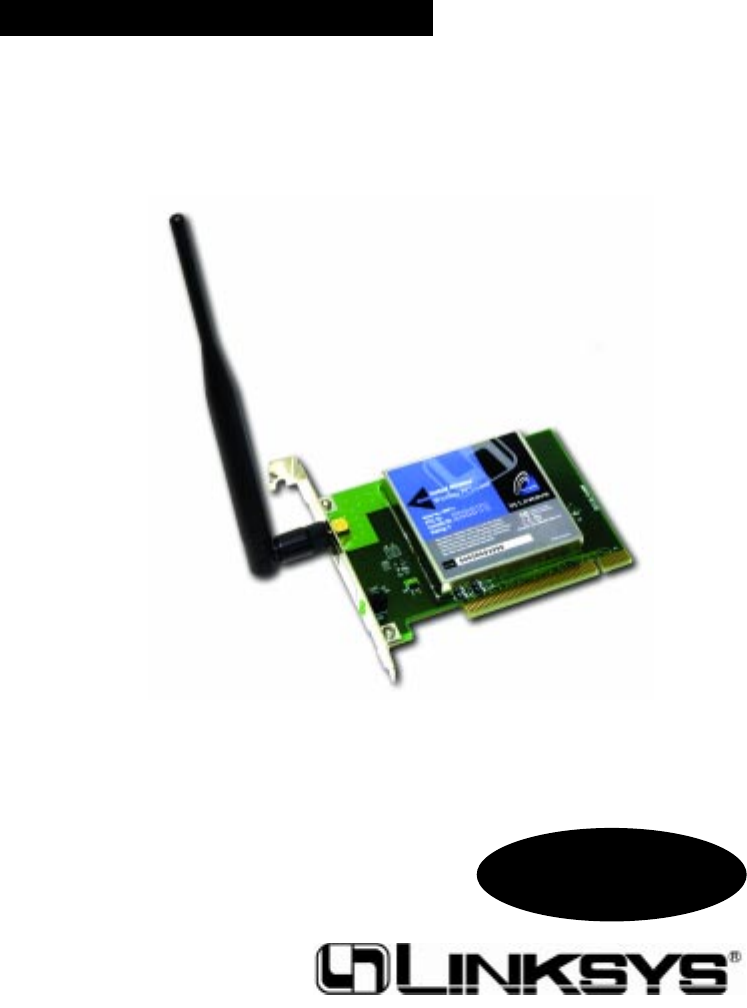
Instant WirelessTM Series
Wireless PCI Card
User Guide
Use this Guide to install the following:
WMP11

COPYRIGHT & TRADEMARKS
Copyright © 2001 Linksys, All Rights Reserved. Instant Wireless™ is a registered trade-
mark of Linksys. Microsoft, Windows, and the Windows logo are registered trademarks
of Microsoft Corporation. All other trademarks and brand names are the property of their
respective proprietors.
LIMITED WARRANTY
Linksys guarantees that every Instant Wireless™ Wireless PCI Card is free from physical
defects in material and workmanship for one year from the date of purchase, when used
within the limits set forth in the Specification section of this User Guide. If these products
prove defective during this warranty period, call Linksys Customer Support in order to
obtain a Return Authorization Number. BE SURE TO HAVE YOUR PROOF OF PUR-
CHASE AND A BARCODE FROM THE PRODUCT'S PACKAGING ON HAND WHEN
CALLING. RETURN REQUESTS CANNOT BE PROCESSED WITHOUT PROOF OF PUR-
CHASE. When returning a product, mark the Return Authorization Number clearly on the
outside of the package and include your original proof of purchase. All customers locat-
ed outside of the United States of America and Canada shall be held responsible for
shipping and handling charges.
IN NO EVENT SHALL LINKSYS’ LIABILITY EXCEED THE PRICE PAID FOR THE PROD-
UCT FROM DIRECT, INDIRECT, SPECIAL, INCIDENTAL, OR CONSEQUENTIAL DAM-
AGES RESULTING FROM THE USE OF THE PRODUCT, ITS ACCOMPANYING SOFT-
WARE, OR ITS DOCUMENTATION. LINKSYS DOES NOT OFFER REFUNDS FOR ANY
PRODUCT. Linksys makes no warranty or representation, expressed, implied, or statuto-
ry, with respect to its products or the contents or use of this documentation and all
accompanying software, and specifically disclaims its quality, performance, mer-
chantability, or fitness for any particular purpose. Linksys reserves the right to revise or
update its products, software, or documentation without obligation to notify any individ-
ual or entity. Please direct all inquiries to:
Linksys P.O. Box 18558, Irvine, CA 92623.
FCC STATEMENT
This product have been tested and complies with the specifications for a Class B digital
device, pursuant to Part 15 of the FCC Rules. These limits are designed to provide rea-
sonable protection against harmful interference in a residential installation. This equip-
ment generates, uses, and can radiate radio frequency energy and, if not installed and
used according to the instructions, may cause harmful interference to radio communi-
cations. However, there is no guarantee that interference will not occur in a particular
installation. If this equipment does cause harmful interference to radio or television
reception, which is found by turning the equipment off and on, the user is encouraged to
try to correct the interference by one or more of the following measures:
• Reorient or relocate the receiving antenna
• Increase the separation between the equipment or device
• Connect the equipment to an outlet other than the receiver’s
• Consult a dealer or an experienced radio/TV technician for assistance
FCC Caution: Any changes or modifications not expressly approved by
the party responsible for compliance could void the user's authority
to operate this equipment.
IMPORTANT NOTE: FCC Radiation Exposure Statement:
This equipment complies with FCC radiation exposure limits set forth
for an uncontrolled environment. This equipment should be installed
and operated with minimum distance 20cm between the radiator & your
body.
This transmitter must not be co-located or operating in conjunction
with any other antenna or transmitter.
UG-WMP11-010821 NC KL

Introduction
Put the “mobile” back into mobile computing! Whether you’re at your desk or
in the boardroom, the Linksys Instant Wireless™ Wireless PCI Card allows you
to share printers, files, and other resources anywhere within your LAN infra-
structure, increasing your productivity and keeping you “in touch.”
The Instant Wireless™ Wireless PCI Card now has a high-powered antenna
that provides greater ranges than ever. Error correction in the chipset keeps you
operating at higher transmission rates for longer distances.
Ready to run in PCs running Windows 95, 98, Millennium, NT, and 2000, the
Instant Wireless™ Wireless PCI Card from Linksys is truly a “must-have” for
all PC users.
• 11 Mbps High-Speed Data Transfer Rate
• Compatible with Virtually All Major Network Operating Systems
• Plug-and-Play Operation Provides Easy Setup
• Integrated Equalizer Recovers Weak Signals and Enhances Sensitivity
• Sturdy Metal Design with Integrated Antenna
• Works with All Standard Internet Applications
• Interoperable with IEEE 802.11b (DSSS) 2.4GHz-Compliant Equipment
• Clear Channel Assessment Increases Network Throughput
• Hardware Buffer Chaining Provides High Performance While Reading and
Writing Buffers
• Capable of up to 128-Bit WEP
• Free Technical Support—24 Hours a Day, 7 Days a Week for North America
Only
• 1-Year Limited Warranty
1
Features
The Instant WirelessTM Wireless PCI Card
Table of Contents
Introduction 1
The Instant WirelessTM Wireless PCI Card 1
Features 1
Package Contents 2
System Requirements 2
Planning Your Wireless Network 3
Network Topology 3
Roaming 3
Installing the Drivers and Configuration Utility for
Windows 95, 98, ME and 2000 4
Before You Start 4
Running the Auto Driver Installation 4
Ad-Hoc Versus Infrastructure Mode 8
Infrastructure Mode 9
Ad-Hoc Mode 11
Installing the Wireless PCI Card 14
Installing the Drivers and Configuration Utility for Windows NT 15
Overview 15
Installing the Drivers for Windows NT 15
Installing the Configuration Utility for Windows NT 29
Configuration Utility 30
Using the Configuration Utility 30
Installing Network Protocols 37
Troubleshooting 39
Common Problems and Solutions 39
Frequently Asked Questions 39
Glossary 43
Specifications 48
Environmental 48
Warranty Information 49
Contact Information 50
Instant WirelessTM Series Wireless PCI Card
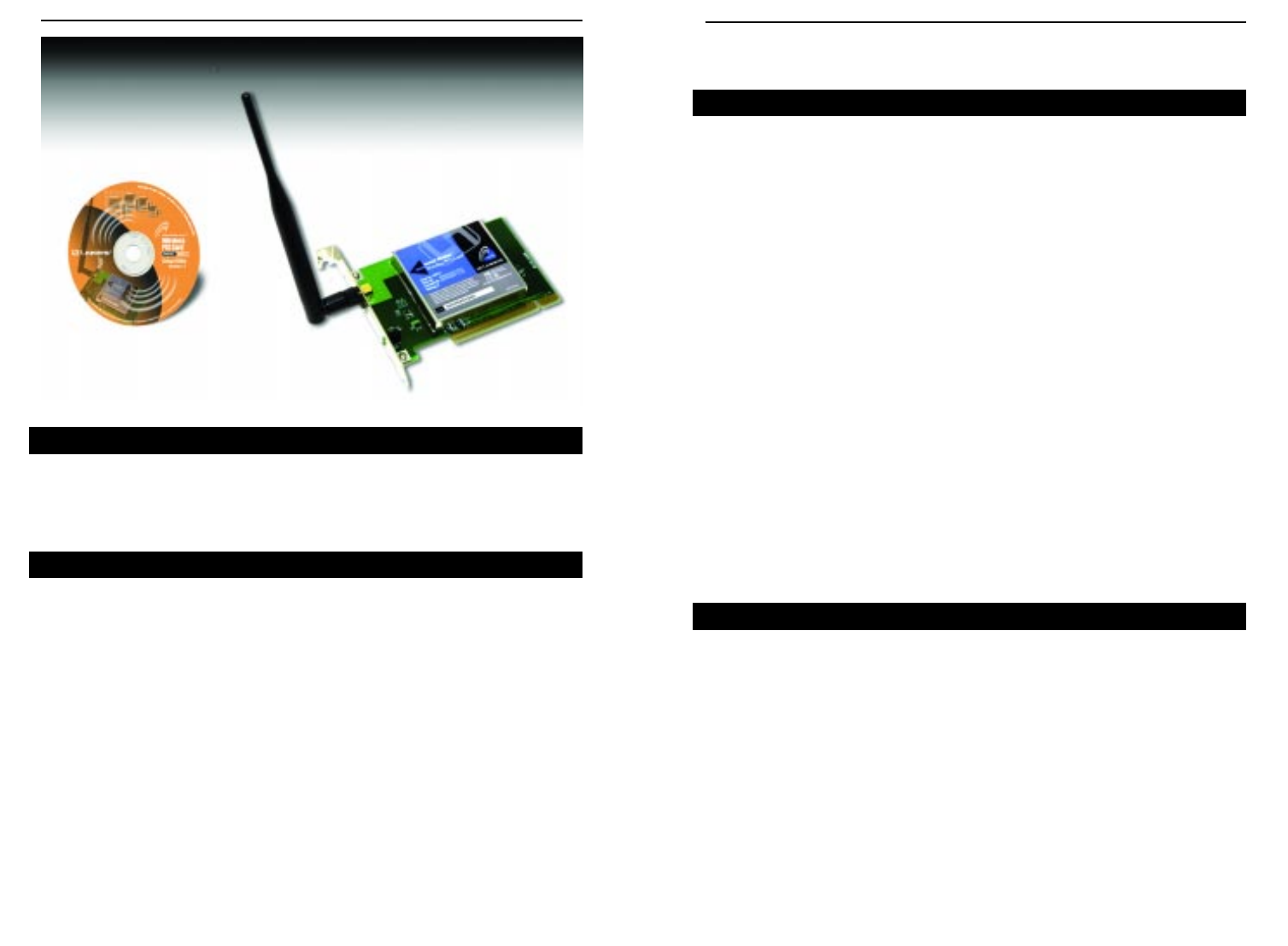
32
Planning Your Wireless Network
Network Topology
A wireless LAN is exactly like a regular LAN, except that each computer in the
LAN uses an Instant Wireless™ Wireless PCI Card to connect to the network
using no wires. Computers in a wireless LAN must be configured to share the
same radio channel.
The Instant Wireless™ Wireless PCI Card provides LAN access for wireless
workstations. An integrated wireless and wired LAN is called an Infrastructure
configuration. A group of Wireless PCI Card users and an Access Point com-
pose a Basic Service Set (BSS). Each PC equipped with an Wireless PCI Card
in a BSS can talk to any computer in a wired LAN infrastructure via the Access
Point.
An infrastructure configuration extends the accessibility of an Wireless PCI
Card PC to a wired LAN, and doubles the effective wireless transmission range
for two Wireless PCI Card PCs. Since the Access Point is able to forward data
within its BSS, the effective transmission range in an infrastructure LAN is
doubled.
The use of a unique ID in a Basic Service Set is essential.
The Wireless LAN Infrastructure configuration is appropriate for enterprise-
scale wireless access to a central database, or as a wireless application for
mobile users.
Infrastructure mode also supports roaming capabilities for mobile users. More
than one BSS can be configured as an Extended Service Set (ESS). This con-
tinuous network allows users to roam freely within an ESS. All Wireless PCI
Card PCs within one Extende Service Set must be configured with the same
SSID.
Selecting a feasible radio channel and optimum Access Point position is rec-
ommended. Proper Access Point positioning combined with a clear radio sig-
nal will greatly enhance performance.
Roaming
• One Instant WirelessTM Wireless PCI Card
• One Setup CD-ROM (Manual on CD)
• Quick Installation Guide and Registration Card (not shown)
• One Free PCI Slot
• Windows 95, 98, Millennium, NT or 2000
• 600 Kbytes of free disk space for utility and driver installation
Package Contents
System Requirements
Instant WirelessTM Series Wireless PCI Card
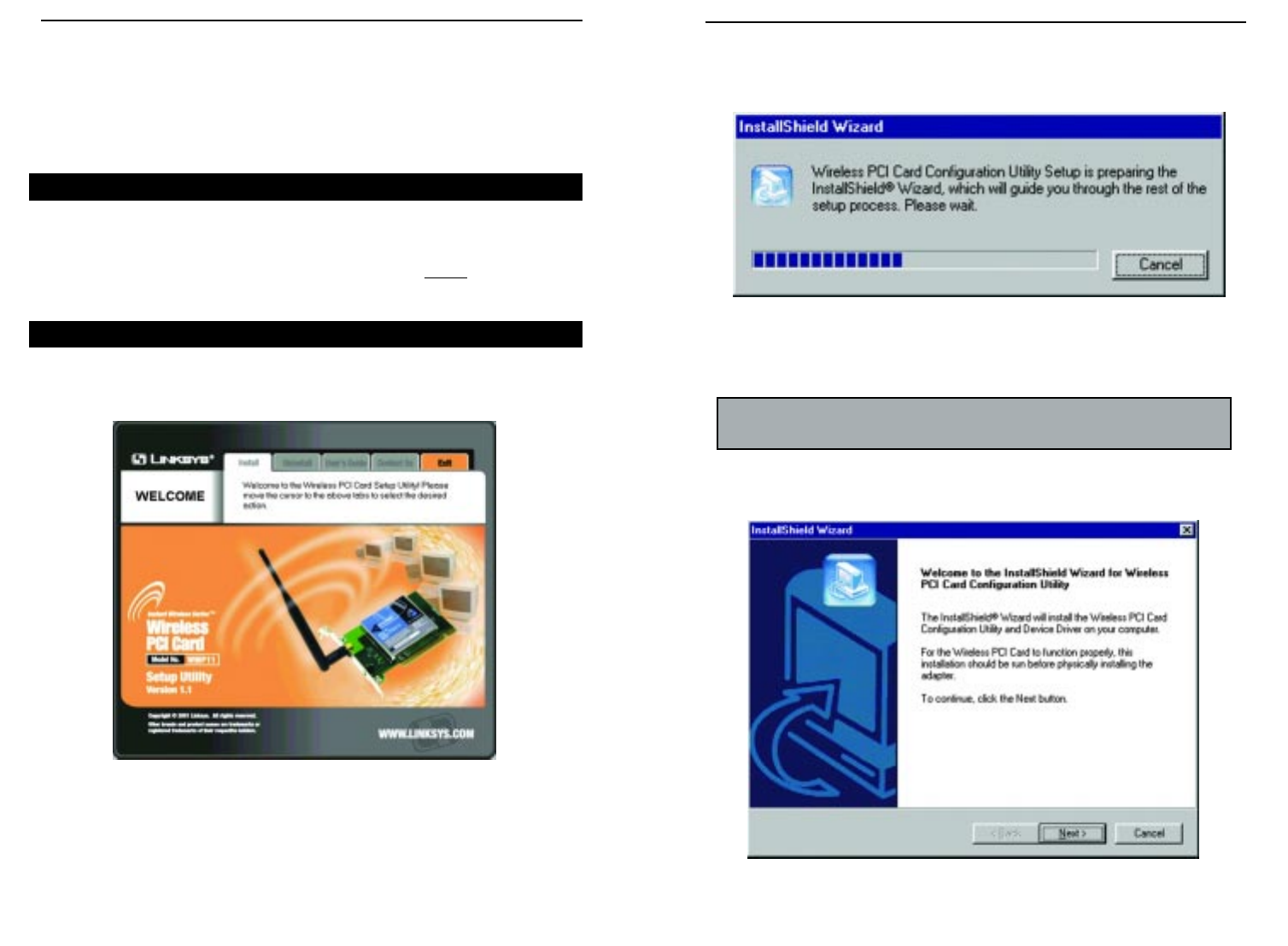
54
2. The first tab across the top of the screen, labeled Install, should now be high-
lighted. Click on the Install button. The following screen should appear,
indicating that Windows is preparing the installation.
If, for whatever reason, you need to abort or terminate the installation, press
the Cancel button at any time during the installation. Otherwise the instal-
lation will continue automatically.
3. This screen will appear next, indicating that Windows is ready to continue
the installation. Click the Next button.
Note: If you stop the installation before it has finished, you will have to
run the installation completely again before installing your hardware.
Installing the Drivers and
Configuration Utility for Windows
95, 98, ME and 2000
Your new Instant Wireless™ Wireless PCI Card comes with an automated soft-
ware installation procedure for Windows 95, 98, Millennium, and 2000.
Windows NT users should refer to the next section. This new procedure auto-
matically installs the drivers and Configuration Utility beforeyou install your
hardware, so there’s no searching for the location of drivers. Again, this step is
taken before installing your hardware.
1. Before installing your adapter, insert the Setup CD into your CD-ROM drive.
Unless you have deactivated the auto-run feature of Windows, the following
screen should appear automatically.
If this screen does not appear automatically, you can access the installation
by pressing the Start button and choosing Run. In the drop down box pro-
vided, type D:\setup.exe (where D: is the letter of your CD-ROM drive).
Alternately, double-click My Computer, and then double-click the CD-
ROM drive where the Setup CD is located. Then double-click the Setup.exe
icon that appears.
Before You Start
Running the Auto Driver Installation
Instant WirelessTM Series Wireless PCI Card
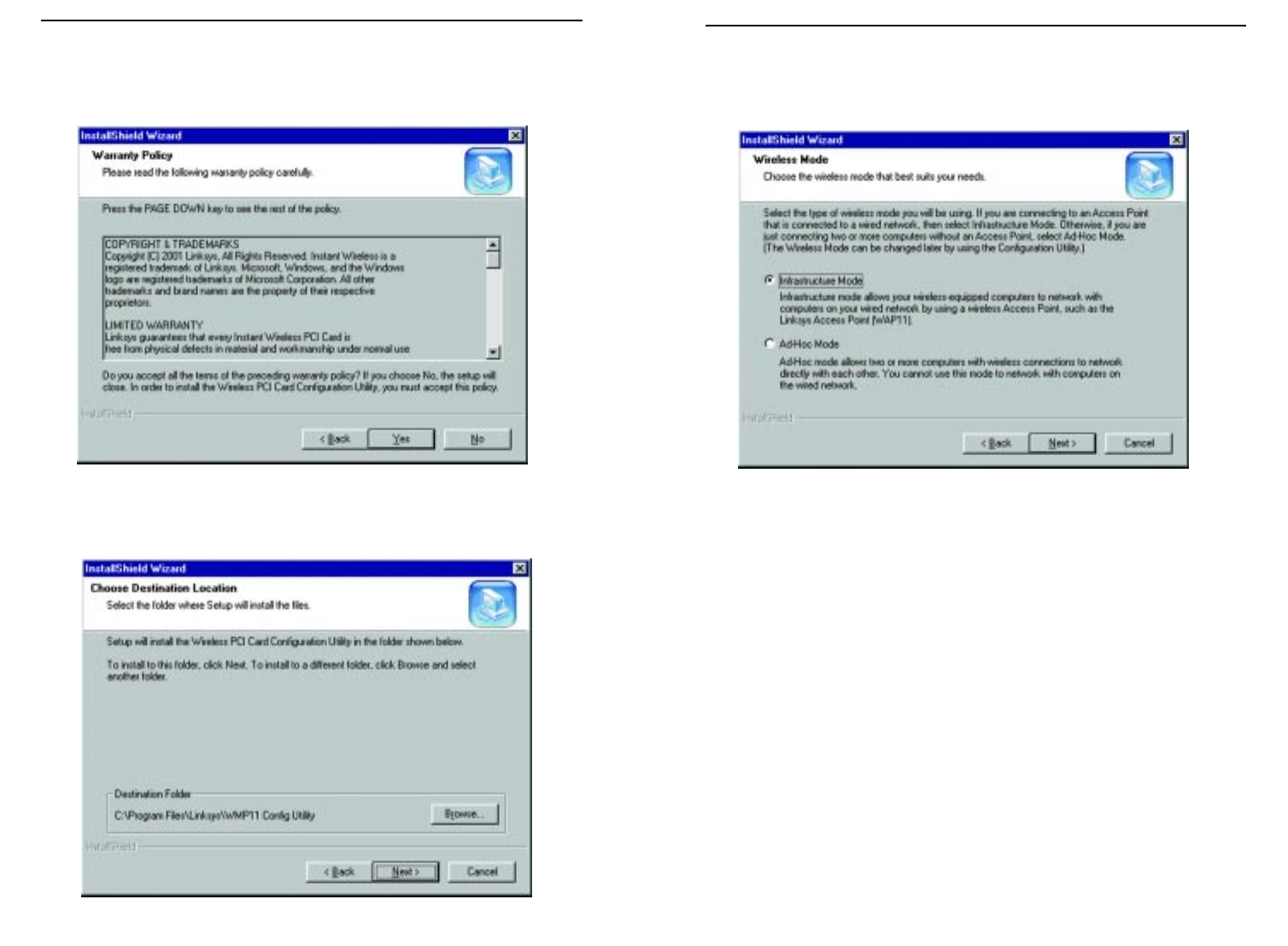
6. When the following screen appears, choose either Infrastructure mode or
Ad-Hoc mode, depending on your needs. If you are unsure whether to
choose Infrastructure or Ad-Hoc, refer to the next section for more informa-
tion. Once you have made your choice, click the Next button.
76
4. The next screen that appears will be the Warranty Policy. Read the entire
policy by pressing the Page Down button on your keyboard. Click on the
Yes button if you agree, or No if you disagree. Clicking No will terminate
the installation. If you click Yes, the installation will continue.
5. The following window will appear next. To install the Configuration Utility
in the default directory (recommended), click the Next button. If you pre-
fer to install the Utility in another directory, click the Browse button, locate
the preferred directory then click the Next button.
Instant WirelessTM Series Wireless PCI Card
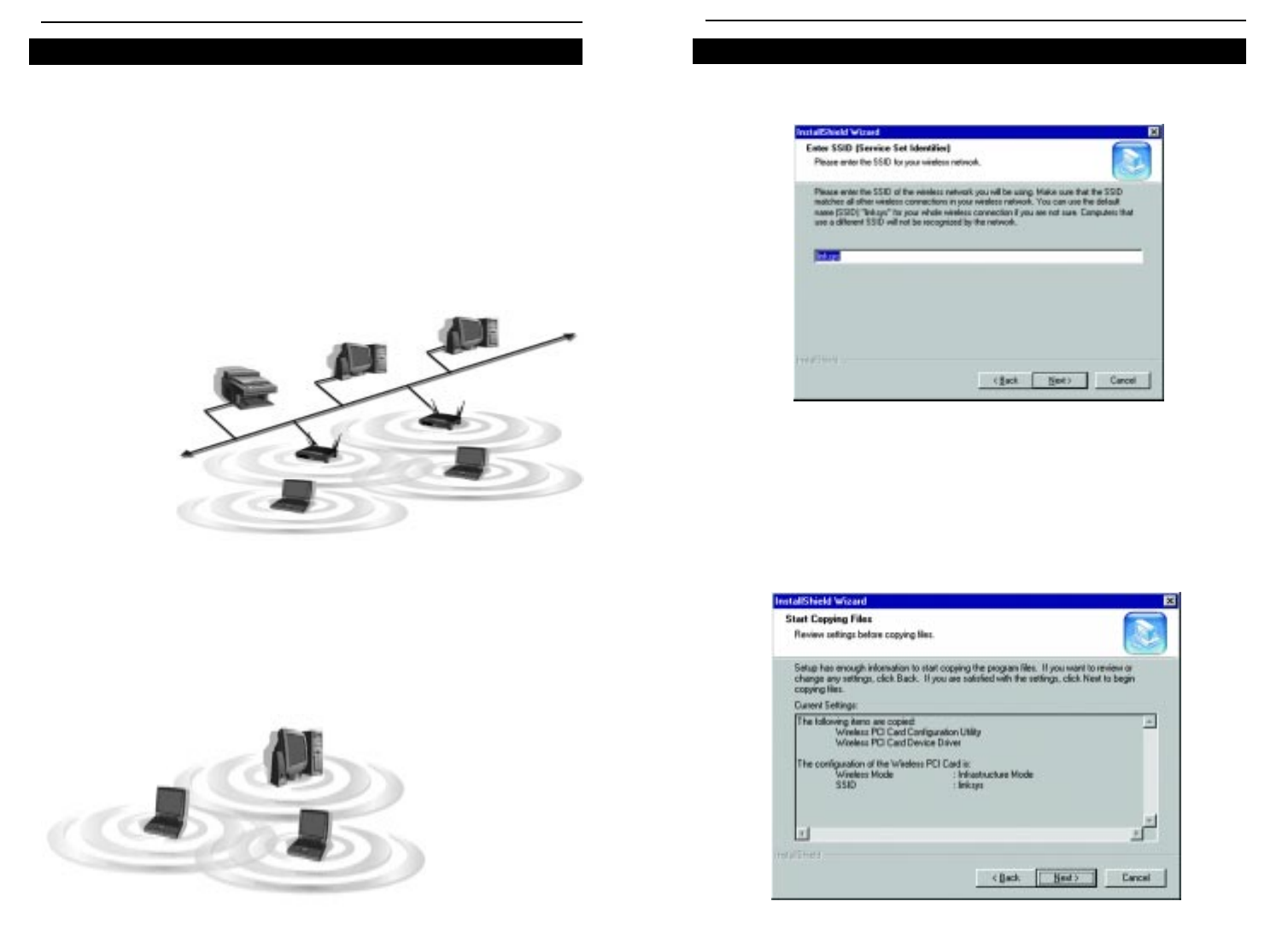
1. If you have chosen Infrastructure mode, the following screen will appear.
If you have chosen Ad-Hoc mode, skip to the next section.
You will be prompted to enter an SSID value in the box provided. The
SSID may be up to 32 characters in length and may include any character
on the keyboard. All SSID values on your wireless network must match. If
you are unsure, use the default value of “linksys”. Then, click the Next but-
ton. Note: All characters are case-sensitive.
2. The next screen to appear will be the Review Settings screen. Verify that
all the settings are correct and click the Next button to continue.
9
Unlike wired networks, wireless networks have two different modes in which
they may be set up: Infrastructure and Ad-Hoc. Choosing between these two
modes depends on whether or not the wireless network needs to share data or
peripherals with a wired network or not.
If the computers on the wireless network need to be accessible by a wired net-
work or need to share a peripheral, such as a printer, with the wired network
computers, the wireless network should be set up in the Infrastructure mode.
The basis of Infrastructure mode centers around an access point, which serves
as the main point of communications in a wireless network. Access points
transmit data to PCs equipped with wireless network card, which can roam
within a certain
radial range of
the access point.
Multiple access
points can be
arranged to work
in succession to
extend the roam-
ing range, and
can be set up to
communicate
with your Ethernet
hardware as well.
If the wireless network is relatively small and needs to share resources only
with the other computers on the wireless network, then the Ad-Hoc mode can
be used. Ad-Hoc mode allows computers equipped with wireless transmitters
and receivers to communicate directly with each other, eliminating the need for
an access point. The drawback of this mode is in the fact that, in Ad-Hoc mode,
wireless-equipped computers are not able to communicate with computers on
a wired network. And,
of course, communica-
tion between the wire-
less-equipped comput-
ers is limited by the dis-
tance and interference
directly between them.
8
Infrastructure Mode
Ad-Hoc versus Infrastructure Mode
Instant WirelessTM Series Wireless PCI Card
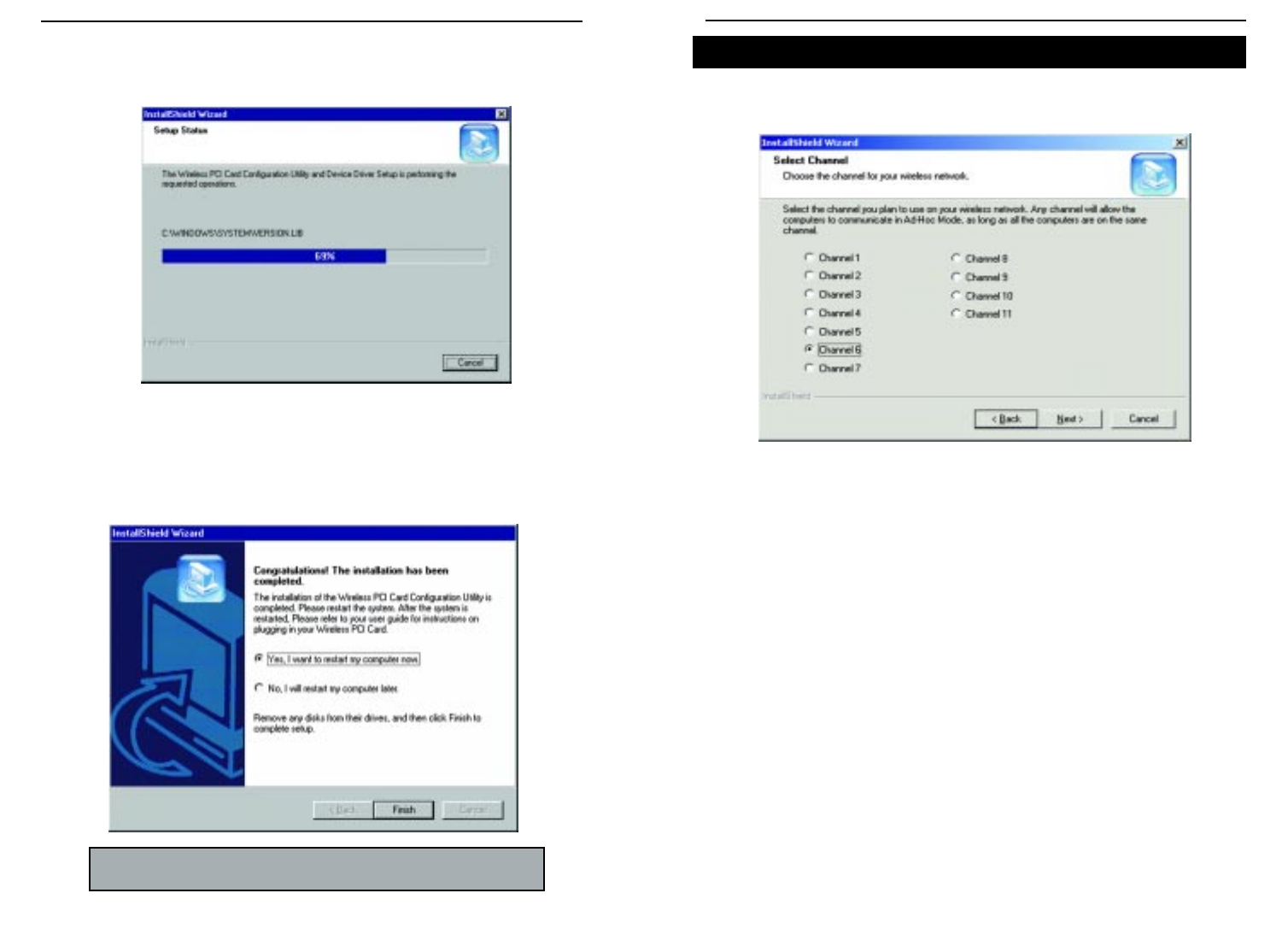
11
3. The following screen will appear, indicating that all of the appropriate files
are being copied onto your drive. Click the Cancel button if you need to
stop the installation for any reason.
4. Once Windows has finished copying the necessary files, the following
screen will appear. In order for the drivers to be installed properly, you
must restart your computer. If you choose to do it now, select Yes, I want
to restart my computer now. If you do not want to do it now, choose No,
I will restart my computer later. Once you have made your choice, click
the Finish button to continue.
10
1. If you have chosen Ad-Hoc mode, the following screen will appear. If you
have chosen Infrastructure mode, refer to the previous section.
You will be prompted to choose a Channel from the list provided. All
computers on your wireless network must be using the same channel in
order to communicate with each other. If you are unsure about which chan-
nel to use, select the default channel (Channel 6). Once you have chosen
your channel, click the Next button.
Ad-Hoc Mode
Note: Restart the computer and go to the section called Installing
the Wireless PCI Card for further instructions.
Instant WirelessTM Series Wireless PCI Card
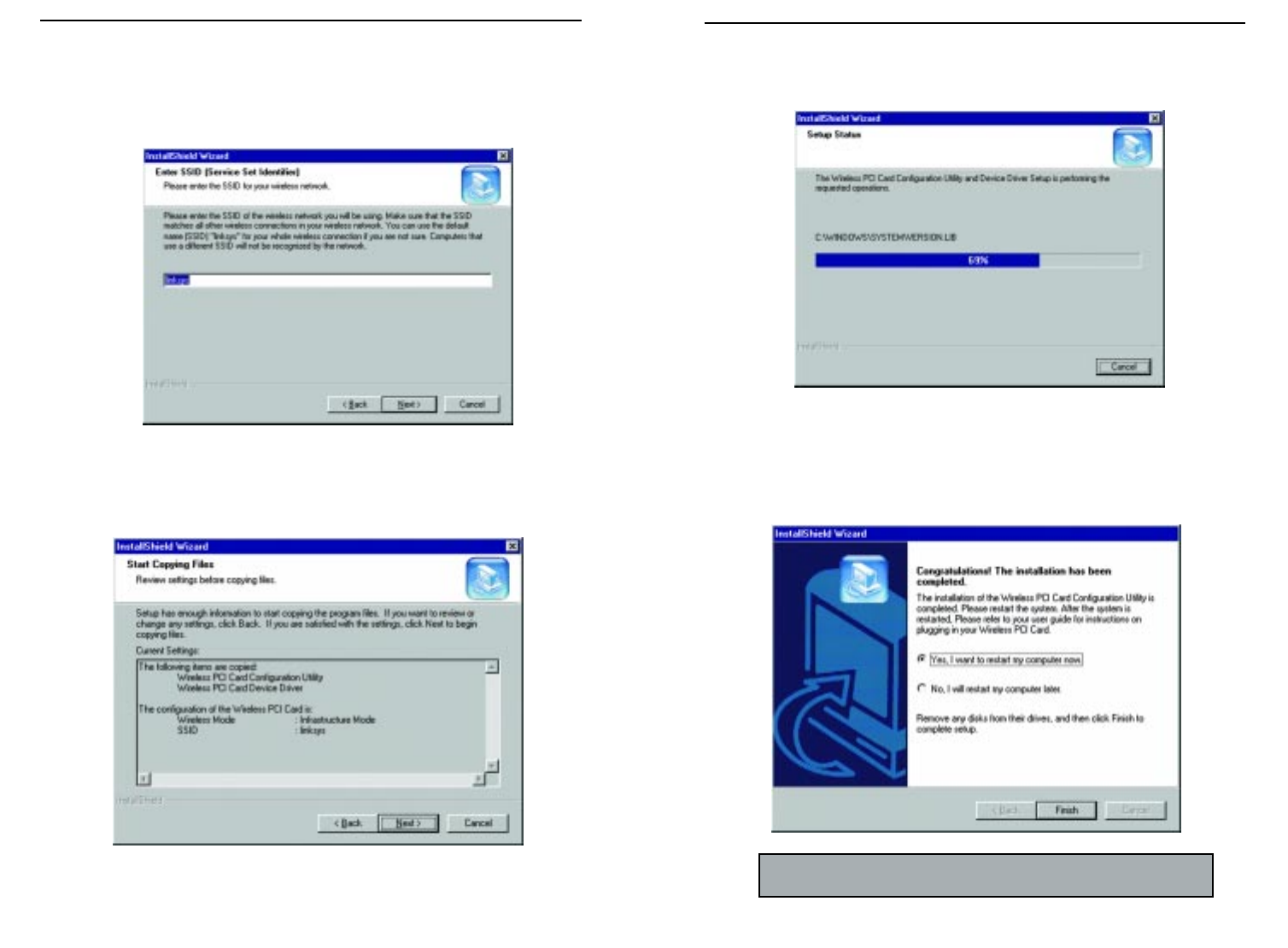
4. The following screen will appear, indicating that all of the appropriate files
are being copied onto your drive. Click the Cancel button if you need to
stop the installation for any reason.
5. Once Windows has finished copying the necessary files, the following
screen will appear. In order for the drivers to be installed properly, you
must restart your computer. If you choose to do it now, select Yes, I want
to restart my computer now. If you do not want to do it now, choose No,
I will restart my computer later. Once you have made your choice, click
the Finish button to continue.
2. The following screen should appear. You will be prompted to enter an SSID
value in the box provided. All SSID values on your wireless network must
match. If you are unsure, use the default value of “linksys”. Then, click the
Next button.
3. The next screen to appear will be the Review Settings screen. Verify that
all the settings are correct and click the Next button to continue.
1312
Note: Restart the computer and go to the section called
Installing the Wireless PCI Card for further instructions.
Instant WirelessTM Series Wireless PCI Card

Installing the Drivers and
Configuration Utility for Windows NT
The installation of the Wireless PCI Card is different for users of Windows NT
because it is not a Plug-and-Play(PnP) system, which means it will not auto-
matically detect the presence of the Wireless PCI Card when it is inserted.
Consequently, the order of the installation is different. The steps involved in
the installation are different, as well. If you are using any other operating sys-
tem than Windows NT, stop here and refer to the section called Installing the
Drivers and Configuration Utility for Windows 95, 98, ME, and 2000.
Windows NT will setup the Wireless PCI Card differently depending upon
whether you’ve previously installed network hardware or not. Please follow the
instructions appropriate for you.
If You Have Never Installed Network Hardware:
1. Windows NT is not a Plug-and-Play Operating System and will not auto-
matically identify the Wireless PCI Card. To begin setup, insert the Setup
Utility CD into your CD-ROM drive. If the Setup Utility CD attempts to
autorun, exit out of the utility to the desktop. Then select Settings from the
Start Menu and bring up the
Control Panel. Then, double-
click on the Network icon.
Overview
Installing the Wireless PCI Card
1. Turn off your desktop PC.
2. Open your PC case and locate an available PCI slot on the motherboard.
Check with your computer manufacturer for instructions.
3. Slide the Wireless PCI Card into the PCI slot. Make sure that all of its
pins are touching the slot's contacts. You may have to apply a bit of pressure
to slide the card all the way in. After the card is firmly in place, secure its
fastening tab to your PC's chassis with a mounting screw. Then, close your
PC.
4. Attach the external antenna to the card’s antenna port.
5. Power on your desktop PC.
The Hardware Installation is complete. Your Wireless PCI Card is set up
and ready for use. You may continue reading to learn about the card’s
Configuration Utility in the Configuration Utility section.
Installing the Wireless PCI Card In Your Desktop PC
1514
Installing the Drivers for Windows NT
Instant WirelessTM Series Wireless PCI Card
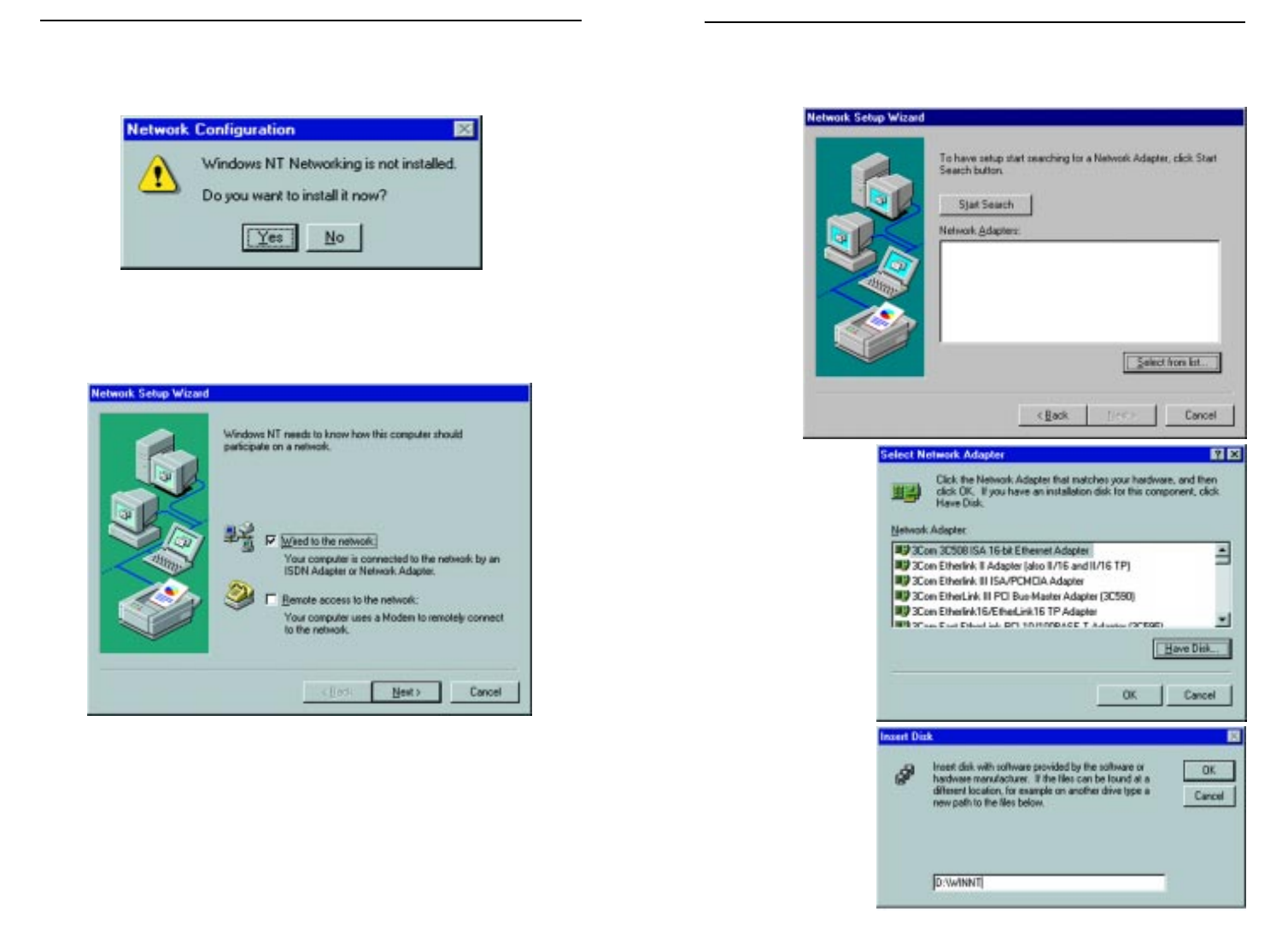
4. The next screen will not show any Network Adapters installed on your sys-
tem, which signifies that no network hardware has been previously installed.
Click the Select from list button to continue.
5.A list of adapters
will appear on the
next screen. You
will not want to
select one of these,
however, as your
installation disk
(Setup Utility CD)
has all of the appro-
priate drivers. Click
the Have Disk but-
ton to continue.
6. When the Insert
Disk screen appears,
type “D:\WINNT”
in the field provided.
Then, click the OK
button to continue.
2. Windows will notify you that Networking is not installed. Click the Yes but-
ton to continue. (If Networking is already installed, proceed to “If You Have
Installed Network Hardware Before”.)
3. Installation will begin and you will reach the screen shown below. You will
want to select the box that reads Wired to the network since you are adding
network hardware. Then, click the Next button to continue.
1716
Instant WirelessTM Series Wireless PCI Card
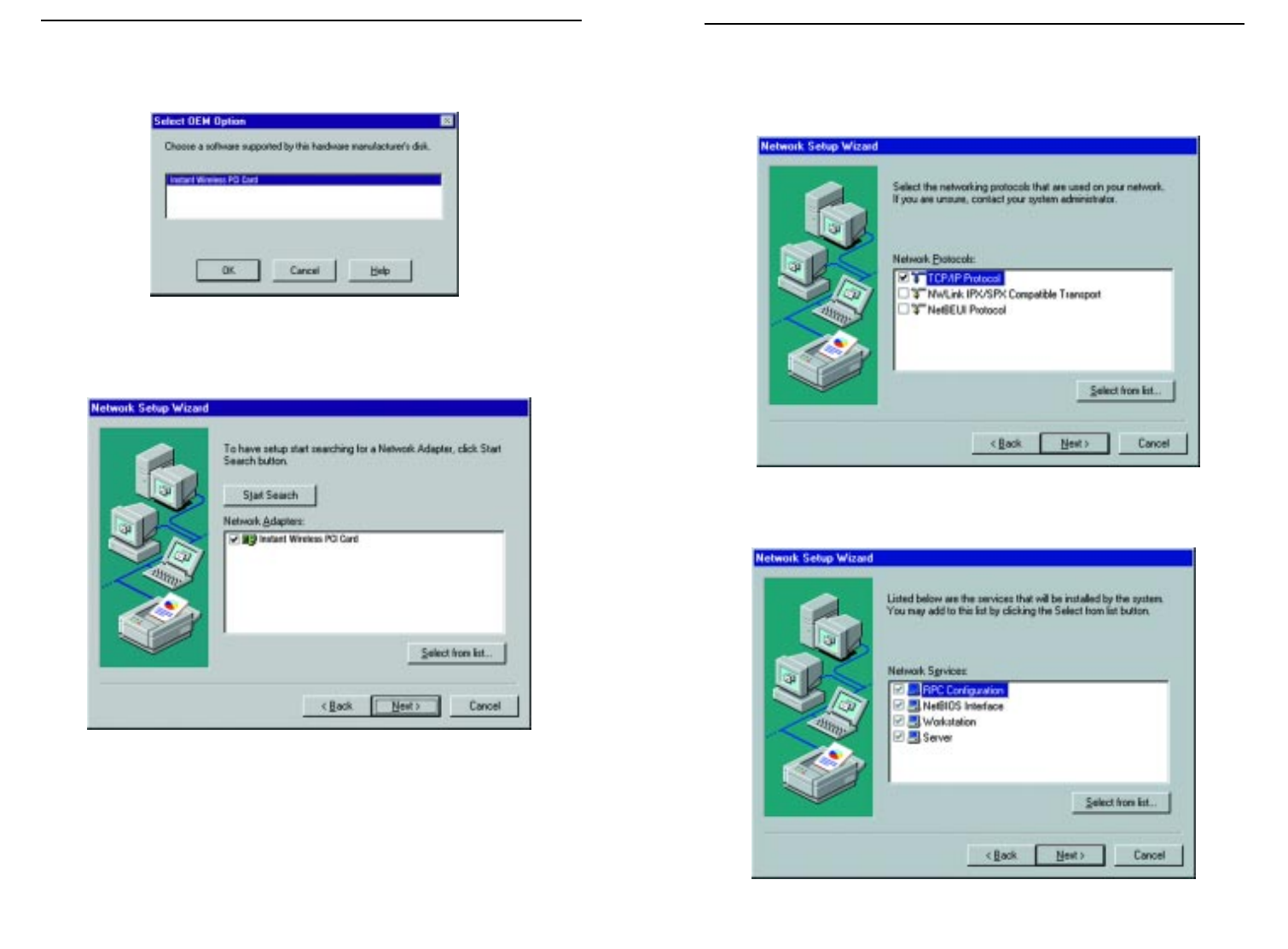
9.The next screen will show a list of network protocols. While the TCP/IP
Protocol is already selected by default, you should check with your network
administrator before installing any additional network protocols. Click the
Next button to continue.
10. On the screen showing Network Services, the selections are automatically
made. Click the Next button to continue.
7.The Select OEM Option screen will display all available adapters. Make
sure that Instant Wireless PCI Card is highlighted and click the OK
button to continue.
8. On the next screen, make sure there is a check mark in the box beside
Instant Wireless PCI Card. Then click the Next button to continue.
19
18
Instant WirelessTM Series Wireless PCI Card
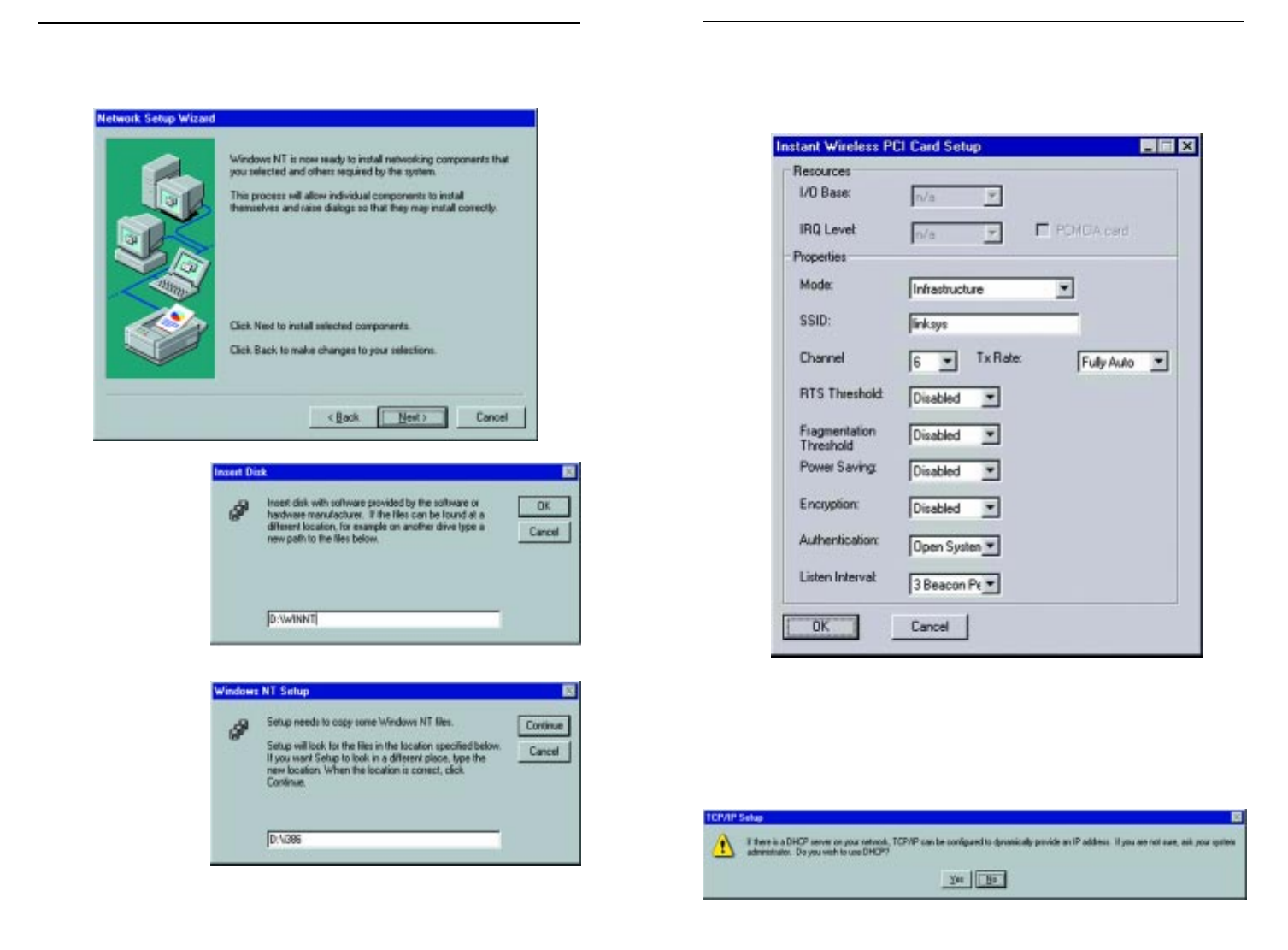
13. You will now reach the screen shown here. This is called the Resources &
Properties screen. Your System Administrator if you have one, will give
you all the information you need concerning these settings. Adjust the set-
tings as are appropriate and click the OK button.
14. After setting the Resource and Properties fields, Windows NT will begin
installing the network components you previously selected. You may be
asked if you would like to configure the protocols with a DHCP server on
your network. If this screen comes up, check with your Network
Administrator before clicking the Yes or No button to continue. This set-
ting may also be changed at a later time.
11. At this point, Windows NT will be ready to start installing Networking
Components. After verifying your selections, click the Next button to con-
tinue. Or, click the Back button to make any necessary corrections.
12. Windows NT may
request further files
at this point. Type
“D:\WINNT” in
the field provided
and click the
Continue button.
If files are still
requested, insert
your Windows NT
CD into your CD-
ROM drive and
type “D:\i386”
(where “D” repre-
sents your CD-
ROM drive). Then,
click the Continue
button.
2120
Instant WirelessTM Series Wireless PCI Card
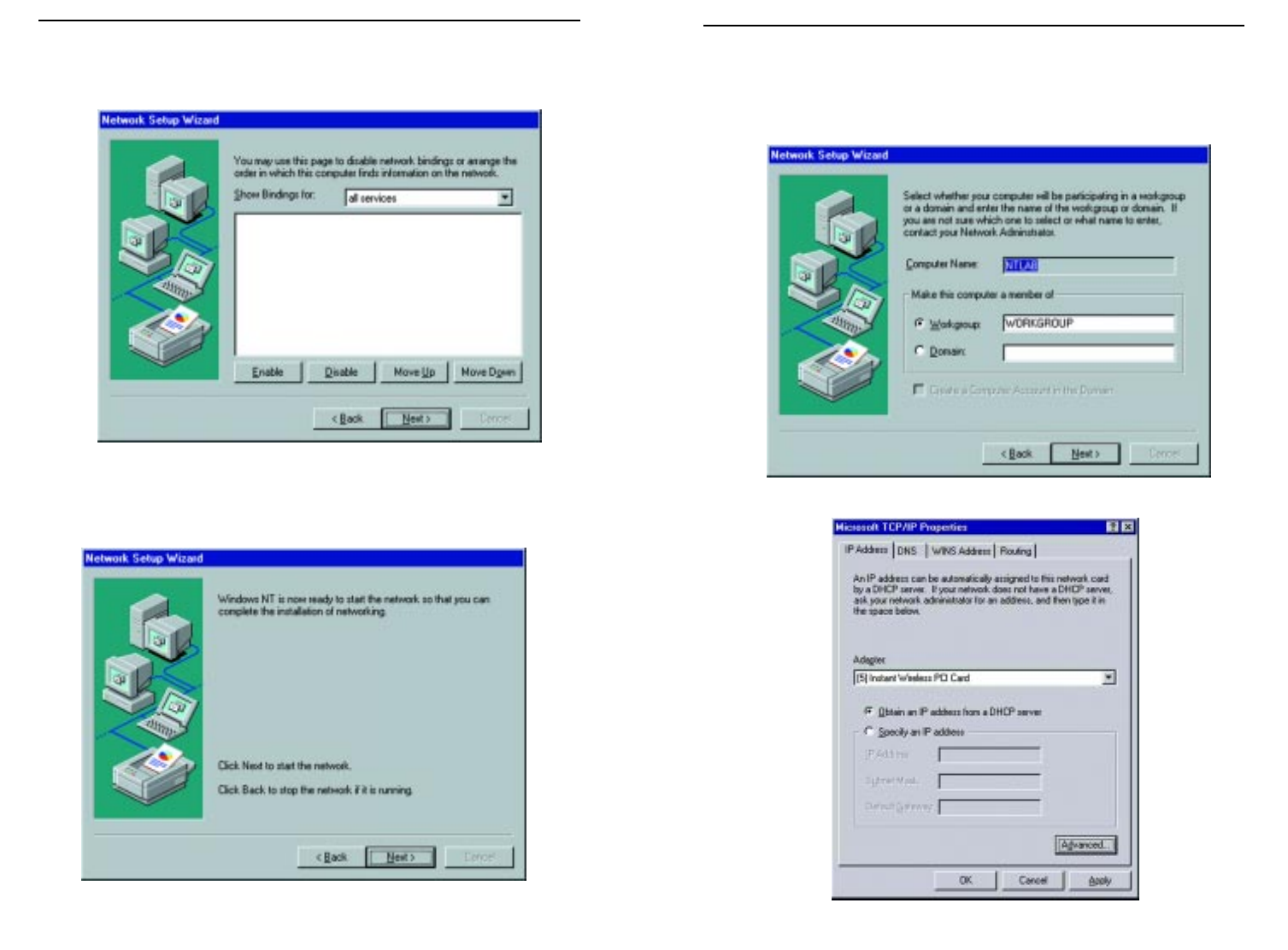
17. On this screen, you will enter your Computer Name, which is how your
computer will be identified on the network. You will also assign the com-
puter to either a Workgroup or Domain, whichever is appropriate. The
Computer Name must be different than any other on the Workgroup or
Domain. Click the Next button.
18. Once the drivers have been installed, the following screen may appear.
15. Now, the network components will finish installing. If a screen similar to
that shown here appears, be sure to check with your network administrator
before making ANY changes and then click the Next button to continue.
16. At this point, Windows NT will let you know that it is ready to start the
network. If you’d like to stop the procedure, click the Back button. To con-
tinue, click the Next button.
2322
Instant WirelessTM Series Wireless PCI Card
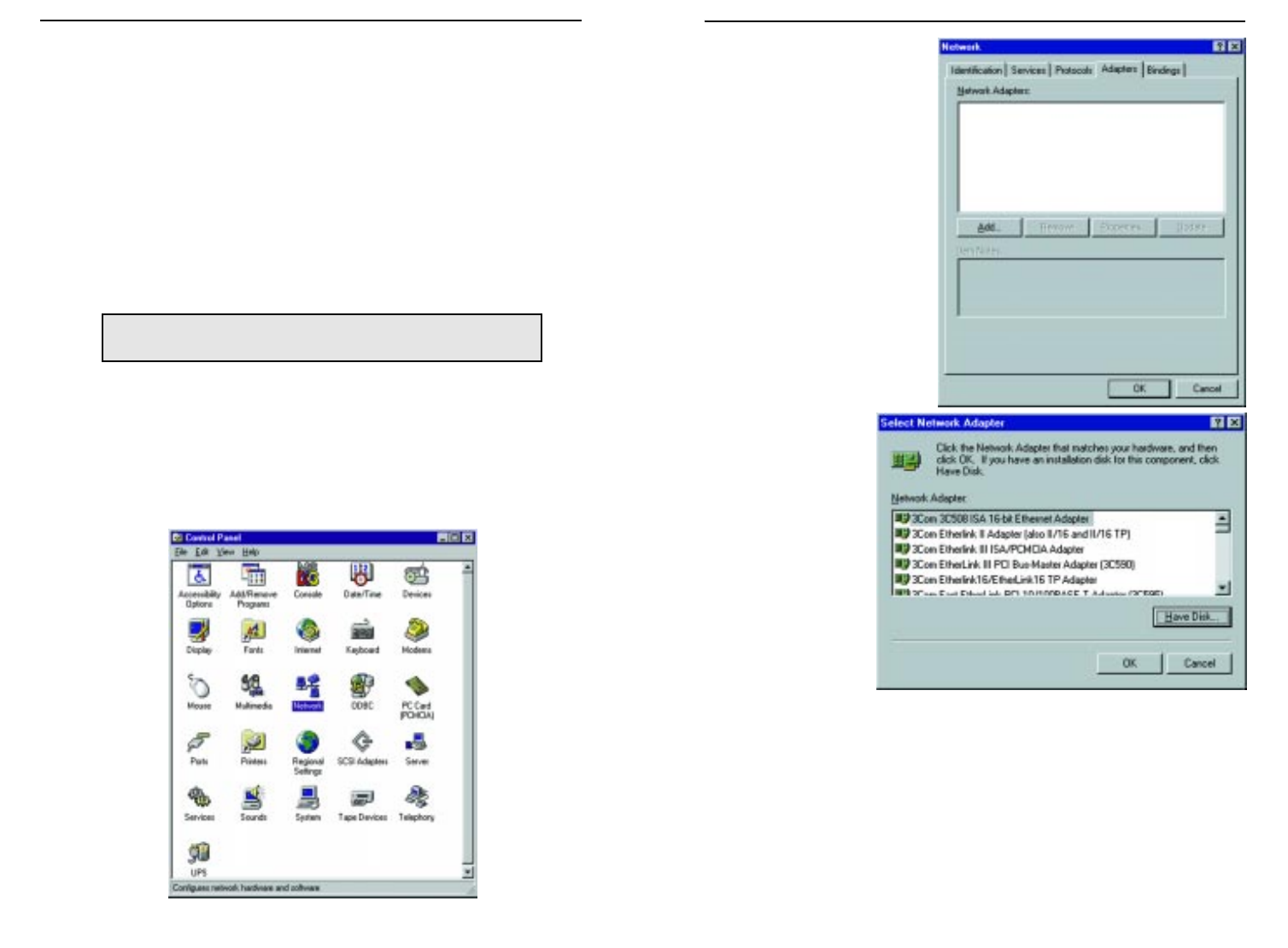
2. To add the Wireless PCI Card,
you will want to click the
Adapters tab and then click
the Add button to continue.
3. A list of adapters
will appear on the
next screen. You will
not want to select
one of these, howev-
er, as your installa-
tion disk (Setup
Utility CD) has all
of the appropriate
drivers. Click the
Have Disk button to
continue.
Make sure that the Instant Wireless™ Wireless PCI Card appears in the
Adapter window. Then, unless you need to assign a static IP address, select
Obtain an IP address from a DHCP server and click the OK button. If
you need to assign a static IP address, select Specify and IP Address, and
enter the appropriate values under IP Address, Gateway Mask, and Default
Gateway. When you have made your choice, click the OK button.
Windows NT has now completed installing the network. Remove the Setup
CD from the CD-ROM drive and click the Finish button to continue. Then
restart your computer.
The Driver Installation is complete. Continue now to the section called
Installing the Configuration Utility for Windows NT.
If You Have Installed Network Hardware Before:
1. Windows NT is not a Plug-and-Play Operating System and will not auto-
matically identify the Wireless PCI Card. To begin setup, insert the Setup
Utility CD into your CD-ROM drive and then select Settings from the Start
Menu and bring up the Control Panel. Then, double-click on the Network
icon.
NOTE: After you have installed the Wireless PCI Card, reapply
the Windows NT service pack.
2524
Instant WirelessTM Series Wireless PCI Card
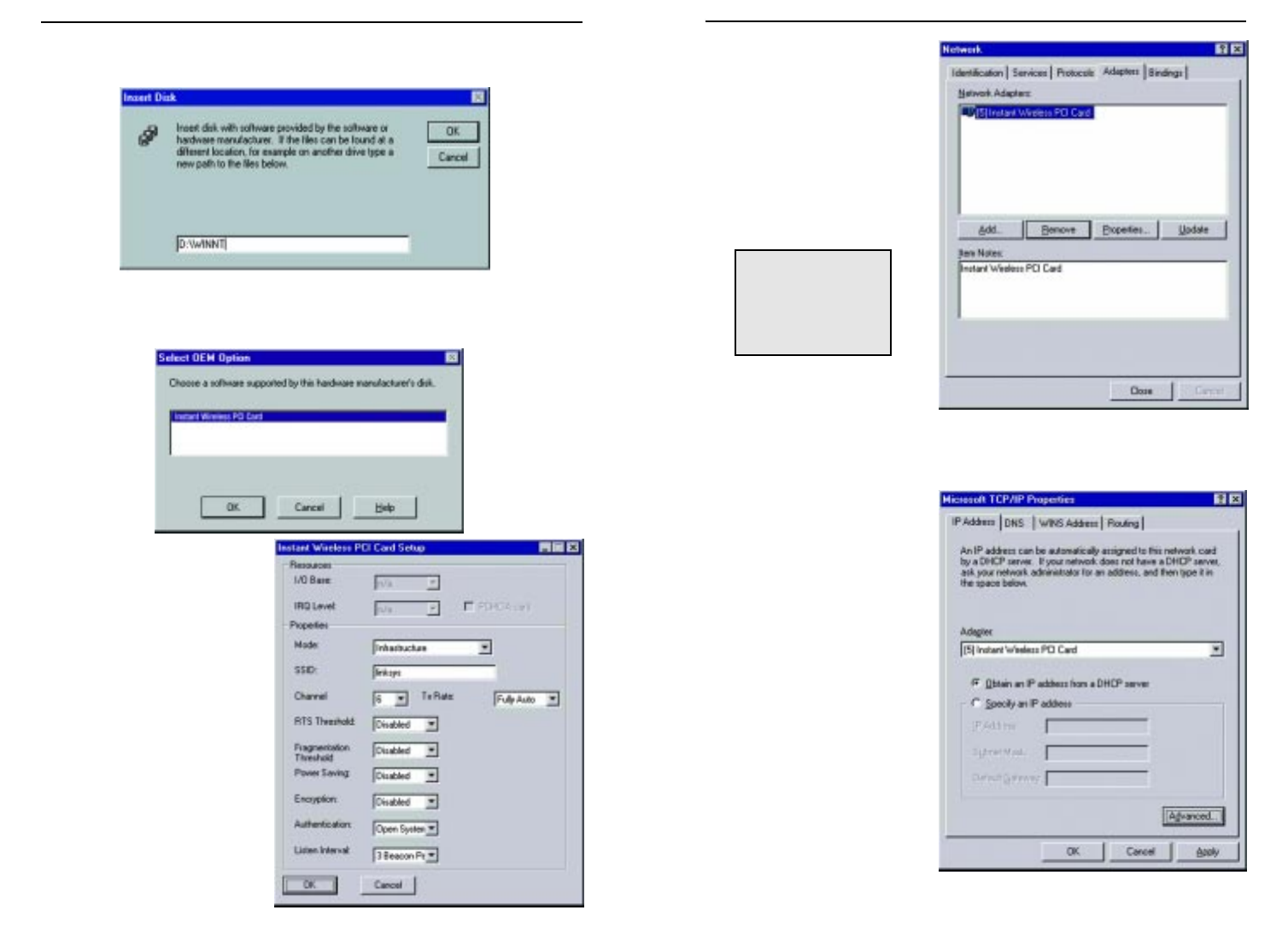
26
7. The Wireless PCI Card has
now been installed. You will
see it added onto this screen.
Click the Close button to
continue and then restart
your computer.
Once the installation has com-
pleted, the following screen
may appear, depending on the
configuration of your comput-
er.
NOTE: After you
have installed the
Wireless PCI Card,
reapply the Windows
NT service pack.
4. On the Insert Disk screen, type “D:\WINNT” in the field provided. Then,
click the OK button to continue.
5. The Select OEM Option screen will display all available adapters. Make
sure that Instant Wireless PCI Card is highlighted and click the OK
button to continue.
6. You will now reach the screen
shown below. This is called
the Resources & Properties
screen. Your System
Administrator will give you
all the information you need
concerning these settings. If
you are the System
Administrator, or just need
more information concern-
ing these settings, refer to the
section called Configuring
the Wireless PCI Card for
Windows NT. Adjust the
settings as are appropriate
and click the OK button.
Instant WirelessTM Series
27
Wireless PCI Card
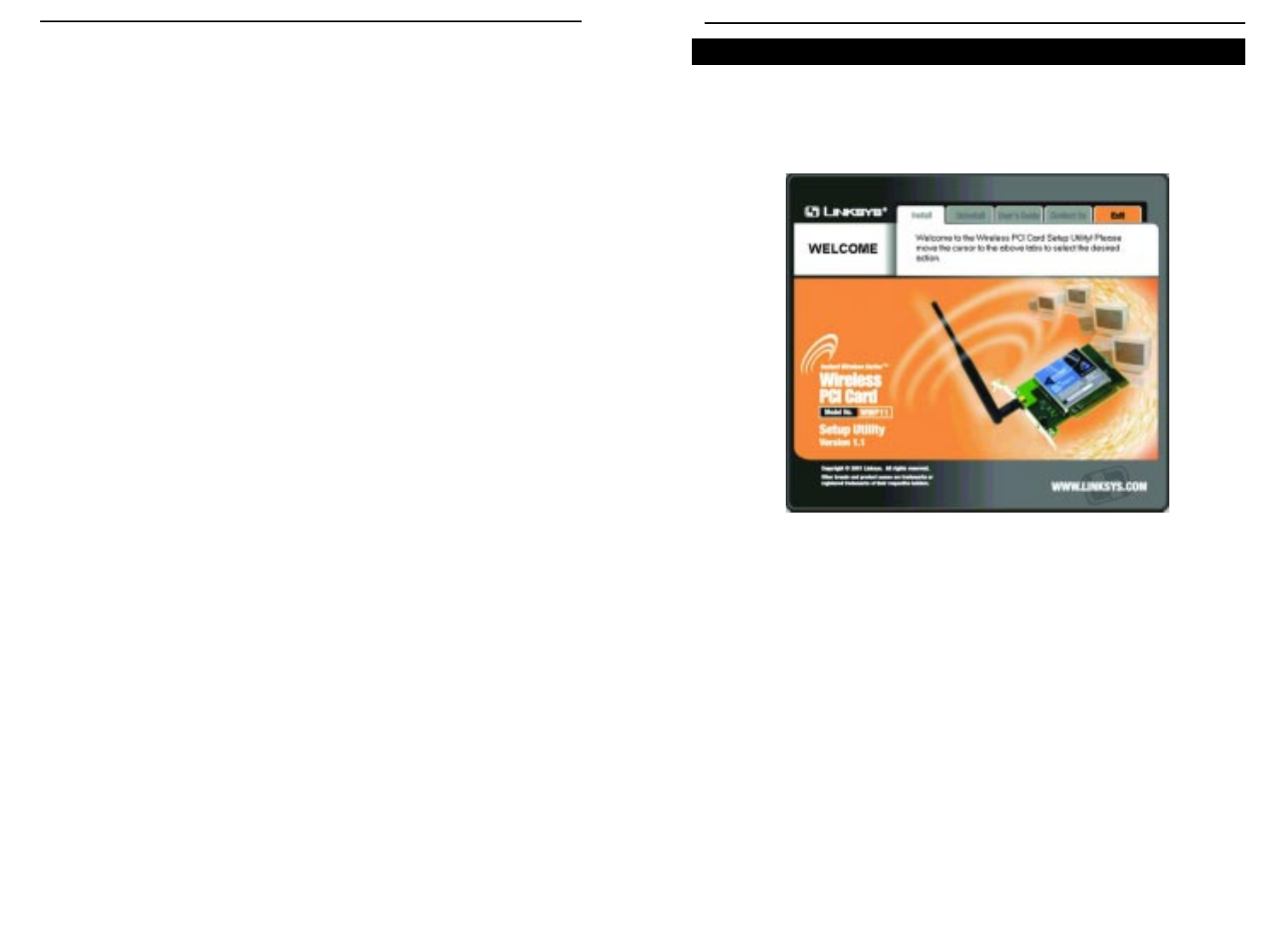
Instant WirelessTM Series
Once you have restarted your computer, the drivers for the Card should load
successfully. Now it is necessary to install the Configuration Utility. Insert
the Setup CD in the CD-ROM drive. Unless you have deactivated the auto-
run feature of Windows, the following screen should appear automatically.
If this screen does not appear automatically, you can access the installation by
pressing the Start button and choosing Run. In the drop down box provided,
type D:\setup.exe (where D: is the letter of your CD-ROM drive).
Alternately, double-click My Computer, and then double-click the CD-ROM
drive where the Setup CD is located. Then double-click the Setup.exe icon
that appears. Follow the instructions that appear on your screen. If you have
any questions or difficulty, refer to the section called Installing the Drivers
and Configuration Utility for Windows 95, 98, ME and 2000.
If the window does appear, make sure that the Instant Wireless™ Wireless
PCI Card appears in the Adapter window. Then, unless you need to assign a
static IP address, select Obtain an IP address from a DHCP server and
click the OK button. If you need to assign a static IP address, select Specify
and IP Address, and enter the appropriate values under IP Address,
Gateway Mask, and Default Gateway. When you have made your choice,
click the OK button.
Windows NT has now completed installing the drivers. Remove the Setup CD
from the CD-ROM drive and click the Finish button to continue. Then restart
your computer.
The Driver Installation is complete. Continue now to the section called
Installing the Configuration Utility for Windows NT.
Installing the Configuration Utility for Windows NT
2928
Wireless PCI Card
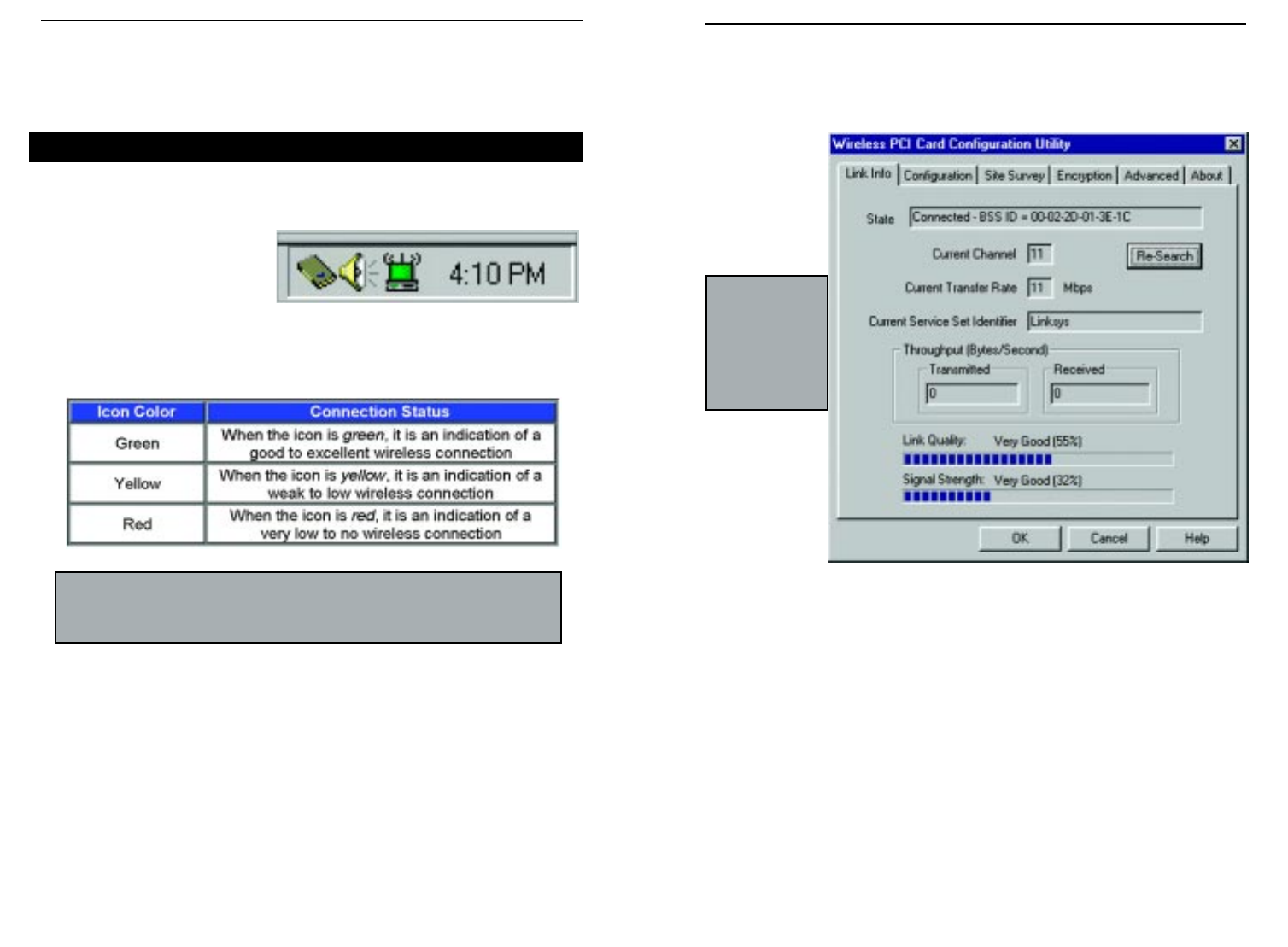
30
LINK INFO
The Link Info screen provides information about the current link between the
Wireless PCI Card and the wireless Access Point.
The Current Channel field shows to what channel the Wireless PCI Card is set.
The Current Transmit Rate field shows the transfer rate in megabits per second.
The Throughput fields show the rate at which data is transferred and received in
Bytes per second.
The Link Quality field will display a bar indicating the percentage, between 0 and
100 percent, of the quality of the link. The higher the percentage, the better the
link.
The Signal Strength field will display a bar indicating the percentage, between 0
and 100 percent, of the strength of the signal. The higher the percentage, the
stronger the signal. (This is to be used as a guide only and not an indicator true
signal strength or quality.)
Note: When in
Ad-Hoc mode,
Link Quality and
Signal Strength
indicators will
not be available.
Configuration Utility
The Configuration Utility is provided to allow you further customization of
the Wireless PCI Card and your wireless network.
Once the Configuration Utility has been installed, an icon will be placed in the
system tray (next to the clock) when the Wireless PCI Card is inserted.
This icon (which looks like a
small computer) serves two pur-
poses. Double-clicking on the
icon will open the Configuration
Utility. The other function of the icon is to indicate the status of your wireless
connection. The icon does this by changing color. The different colors each
indicate a different quality of wireless connection. The chart below details
what the colors are and what each one means.
You can also start the Configuration Utility by pressing the Start button and
selecting Wireless PCI Card. Then choose Configuration Utility. You will see
the Wireless LAN Configuration Utility screen. This utility is divided into four
parts: Link Info, Configuration, Site Survey, Encryption, Advanced, and
About. It is recommended that you change all configuration settings for your
Wireless PCI Card using this utility and not under the Network Properties sec-
tion in your Control Panel.
Instant WirelessTM Series
Using the Configuration Utility
Note: In Ad-Hoc mode, the icon will always appear green. When in
this mode, the icon color does not apply to the Link Quality and Signal
Strength of the wireless connection.
31
Wireless PCI Card
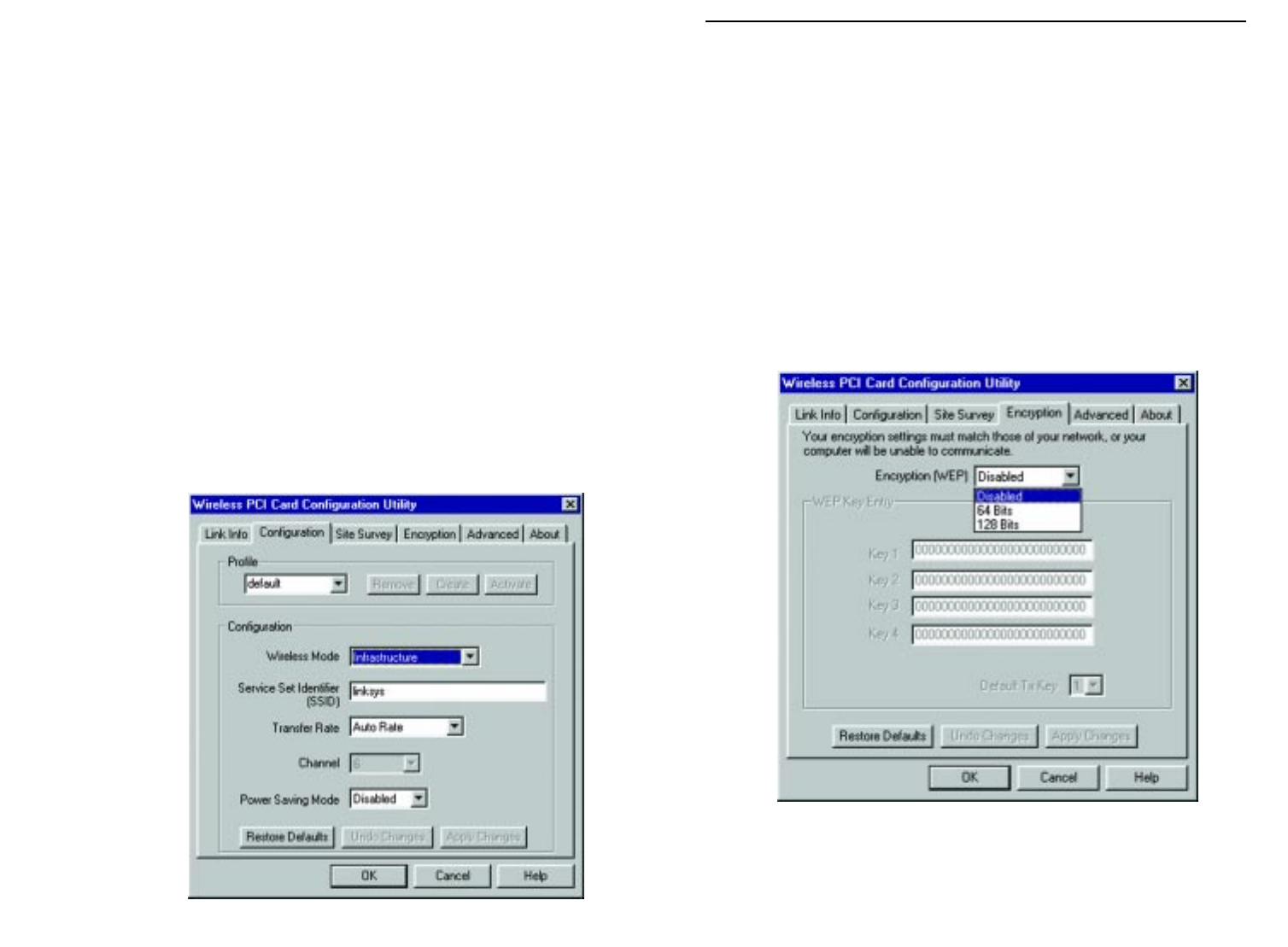
3332
The Channel setting specifies the channel used in wireless communication and
should be set to the same channel as the other points in the wireless network.
This setting can only be adjusted in Ad-Hoc mode.
ENCRYPTION
The 64-bit or 128-bit WEP keys can be generated from a user-defined
passphrase or entered manually.
An acronym for Wired Equivalent Privacy, WEP is an encryption scheme used
to protect your wireless data communications. WEP uses a combination of 64-
bit or 128-bit keys to provide access control to your network and encryption
security for every data transmission. To decode a data transmission, each point
in a network must use an identical 64-bit or 128-bit key. Higher encryption
levels mean higher levels of security, but, due to the complexity of the encryp-
tion, they may mean decreased network performance.
Encryption (WEP) can be Disabled, or set to 64-bit or 128-bit encryption as
a hexadecimal number for each key that you wish to encrypt. Make sure that
the values entered in these fields for WEP is identical to the encryption keys
used on the other wireless devices on the network.
CONFIGURATION
The Configuration screen allows you to customize the settings for the Wireless
PCI Card and your wireless network. Once these are set, you can save these
configuration settings with the Profile function. Click Create to save your con-
figuration settings and Activate to use these settings. To delete settings you
have saved, use the Remove button.
The Wireless Mode setting determines the architecture of your wireless net-
work. Select Ad-Hoc or Infrastructure Mode depending on your network
type. The Ad-Hoc mode is used for a simple peer-to-peer network and allows
the sharing of local resources only between Wireless PCI Cards without need-
ing a wireless Access Point. The Infrastructure mode allows a wireless net-
work to be integrated into an existed, wired network through an Access Point.
Infrastructure networks permit roaming between Access Points while main-
taining a connection to all network resources.
An acronym for Service Set Identifier, SSID is the unique name shared among
all points in a wireless network. The SSID must be identical for all points in the
network. It is case sensitive and must not exceed 32 characters.
The Transfer Rate field shows the current transfer rate for the Wireless PCI
Card. To optimize
performance and
range, the TX Rate
should be set to
Fully Automatic,
which will automati-
cally adjust the
transfer speed for
best performance
and longest range.
Power Saving Mode,
or PS Mode,
enables or disables
the power saving
features of your
Wireless PCI Card.
Instant WirelessTM Series Wireless PCI Card
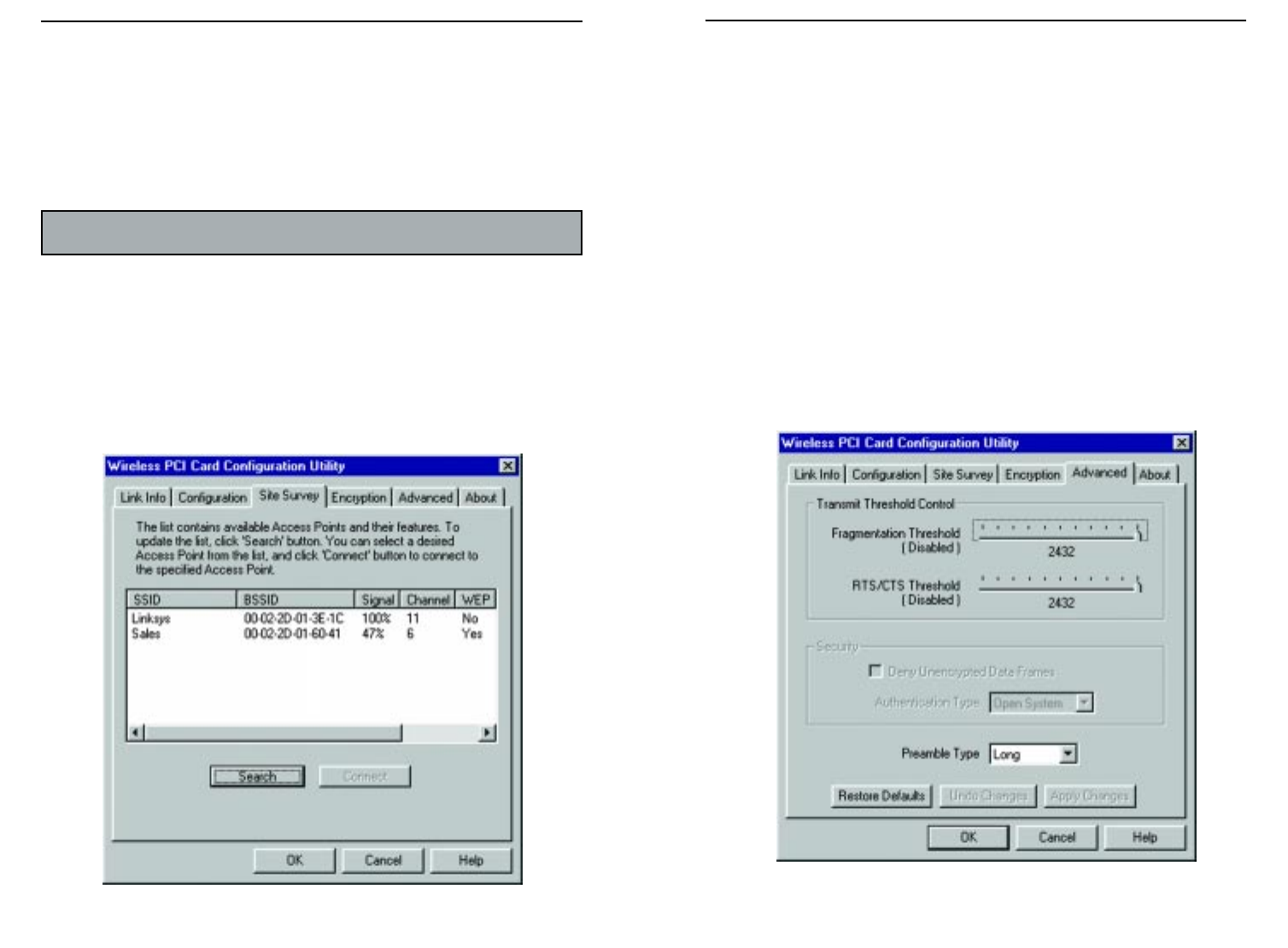
The Default Key can then be set by selecting any of the four keys that have been
entered in the Manual Entry fields. That key will then be the one used auto-
matically by the Wireless PCI Card.
Once you have chosen your key encryption method and entered either the
Passphrase or manual key, click the Apply Changes button Then click the OK
button and the encryption portion of the setup is complete. To undo these
changes, click the Undo Changes button.
You can also restore the card’s default settings by clicking the Restore Defaults
button.
ENCRYPTION
The Site Survey tab will show you that available Access Points and their fea-
tures. Click on the desired Access Point, then click Connect to connect or
Search to search for more Access Points. Click OK when you are finished.
Instant WirelessTM Series
Note: Make sure that the values entered in these fields for WEP are identical
to the encryption keys used on the other wireless devices on the network.
34
ADVANCED
The Advanced tab allows you to set the Fragmentation Threshold, the
RTS/CTS Threshold, and the Preamble Type. The Fragmentation Threshold
Value indicates how much of the network resources are devoted to recovering
packet errors. The value should remain at its default setting of 2,436. If you
experience high packet error rates, you can decrease this value, but it will like-
ly decrease overall network performance. Only minor modifications of this
value are recommended.
The RTS Threshold Value should remain at its default setting of 2,437. A pre-
amble is a signal used to synchronize the transmission timing between two or
more systems. A series of transmission pulses is sent before the data to indi-
cate that "someone is about to transmit data". This ensures that systems receiv-
ing the information correctly interpret when the data transmission starts.
Security is used for WEP only. By selecting Deny Unencrypted Data
Frames, all unencrypted data will not be seen. For Authentication Type, you
may choose between Open System or Shared Key.
.
35
Wireless PCI Card
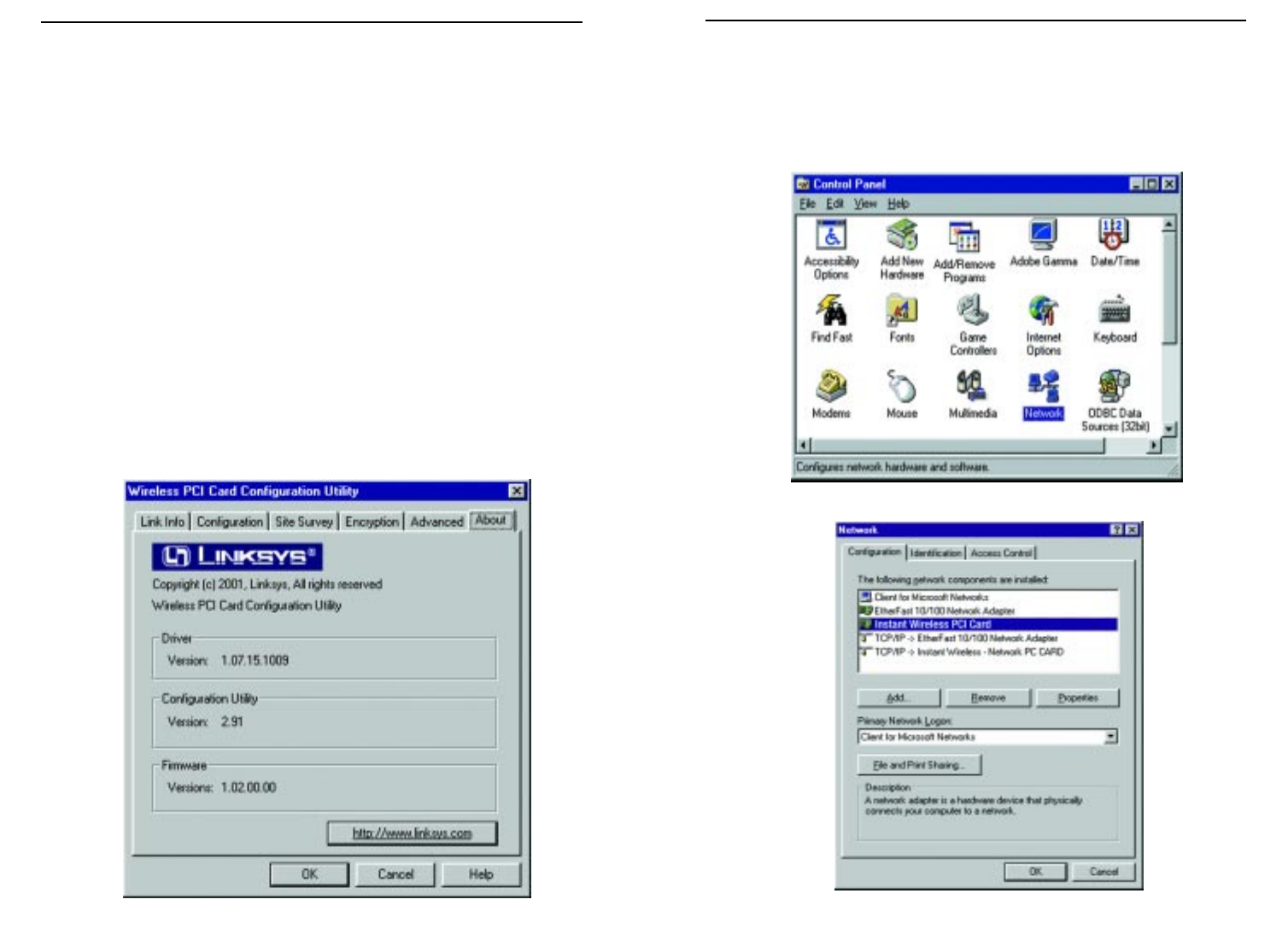
Installing Network Protocols
Protocols are necessary for computers to communicate on your network.
1. From the Start Menu, select Settings and bring up the Control Panel. From
the Control Panel, double-click on the Network icon.
2. Select the Wireless PCI Card from the list and click the Add button.
37
Shared Key is when both the sender and recipient share a secret key. Both units
use this key for an extended length of time, sometimes indefinitely. Any eaves-
dropper that discovers the key may decipher all packets until the key is
changed.
Open System, the default setting, is when the sender and the recipient do not
share a secret key. Each party generates its own key-pair and asks the receiver
to accept the (usually randomly) generated key. Once accepted, this key is used
for a short time only, then a new key is generated and agreed upon. Even if the
secret key is discovered, only a small amount of data may be decrypted.
The Preamble Mode should be set to Long (if in a “noisy” network environ-
ment), Short (if the environment is clear), or click OK to complete the con-
figuration
ABOUT
The About screen shows the release information for the Driver Version,
Configuration Utility Version, and Firmware Version. You can also connect
directly to the Linksys web site with your active internet connection by click-
ing the button showing the internet address at the bottom of the screen.
36
Instant WirelessTM Series Wireless PCI Card
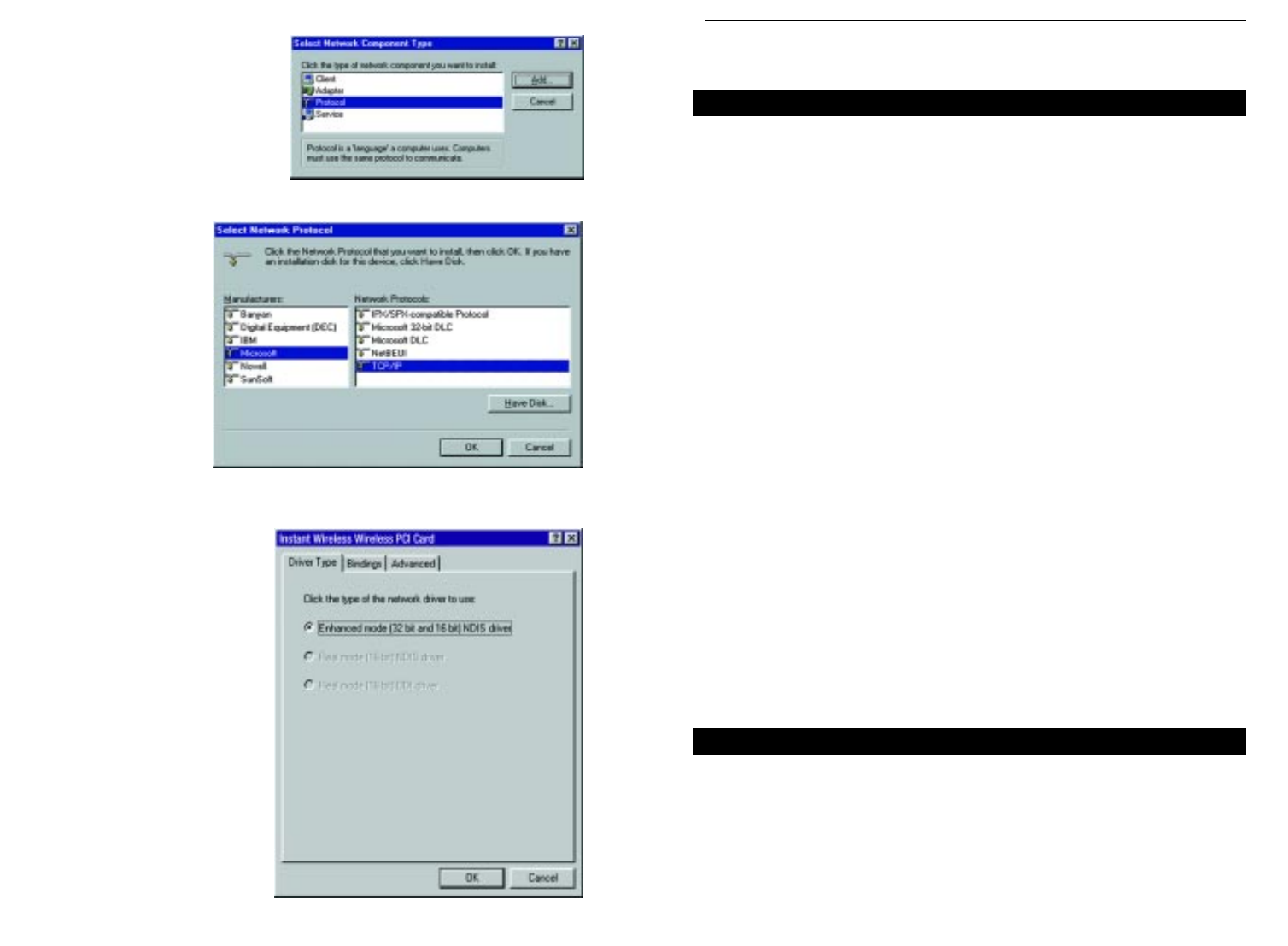
39
3. Highlight Protocol and click
the Add button.
4. Select Microsoft
from the list of
“Manufacturers”
and TCP/IP from
the list of “Network
Protocols” and
click the OK but-
ton.
5. Repeat steps two through four to install other protocols such as NetBEUI or
IPX/SPX.
From the screen in step two,
you can also press the
Properties button. From this
screen, you can verify that
the drivers are working under
Enhanced Mode on the
Driver Type tab or reconfig-
ure the card on the Advanced
tab.
At this point, you must
restart your computer.
Installation is complete.
38
Troubleshooting
This chapter provides solutions to problems usually occurring during the instal-
lation and operation of the Wireless PCI Card. Read the description below to
solve your problems. If you can’t find an answer here, check the Linksys web-
site at www.linksys.com.
1.The Wireless PCI Card does not work properly.
• Reinsert the Wireless PCI Card into your PC’s PCI slot.
• Right click on My Computer and select Properties. Select the device man-
ager and click on the Network Adapter. You will find the Wireless PCI Card
if it is installed successfully. If you see the yellow exclamation mark, the
resources are conflicting. You will see the status of the Wireless PCI Card. If
there is a yellow question mark, please check the following:
• Make sure your PC has a free IRQ.
• Make sure you have inserted the right card and installed the proper
driver.
If the Wireless PCI Card does not function after attempting the above steps,
remove the card and do the following:
• Uninstall the driver software from your PC.
• Restart your PC and repeat the hardware and software installation as
specified in this User Guide.
3.I cannot communicate with the other computers linked via Ethernet in
the Infrastructure configuration.
• Make sure that the notebook PC to which the Wireless PCI Card is associat-
ed is powered on.
• Make sure that your Wireless PCI Card is configured on the same channel
and with the same security options as with the other computers in the
Infrastructure configuration.
Can I run an application from a remote computer over the wireless net-
work?
This will depend on whether or not the application is designed to be used over
a network. Consult the application's user guide to determine if it supports oper-
ation over a network.
Common Problems and Solutions
Instant WirelessTM Series Wireless PCI Card
Frequently Asked Questions

factors as signal strength and quality, as well as the message load currently
being carried by each Access Point and the distance of each Access Point to the
wired backbone. Based on that information, the node next selects the right
Access Point and registers its address. Communications between end node and
host computer can then be transmitted up and down the backbone.
As the user moves on, the end nodes RF transmitter regularly checks the sys-
tem to determine whether it is in touch with the original Access Point or
whether it should seek a new one. When a node no longer receives acknowl-
edgment from its original Access Point, it undertakes a new search. Upon find-
ing a new Access Point, it then reregisters, and the communication process con-
tinues.
What is BSS ID?
A specific Ad hoc LAN is called a Basic Service Set (BSS). Computers in a
BSS must be configured with the same BSS ID.
What is ESS ID?
An Infrastructure configuration could also support roaming capability for
mobile workers. More than one BSS can be configured as an Extended Service
Set (ESS). Users within an ESS could Roam freely between BSSs while served
as a continuous connection to the network wireless stations and Access Points
within an ESS must be configured with the same ESS ID and the same radio
channel.
What is ISM band?
The FCC and their counterparts outside of the U.S. have set aside bandwidth
for unlicensed use in the ISM (Industrial, Scientific and Medical) band.
Spectrum in the vicinity of 2.4 GHz, in particular, is being made available
worldwide. This presents a truly revolutionary opportunity to place convenient
high-speed wireless capabilities in the hands of users around the globe.
What is Spread Spectrum?
Spread Spectrum technology is a wideband radio frequency technique devel-
oped by the military for use in reliable, secure, mission-critical communica-
tions systems. It is designed to trade off bandwidth efficiency for reliability,
integrity, and security. In other words, more bandwidth is consumed than in the
case of narrowband transmission, but the trade off produces a signal that is, in
effect, louder and thus easier to detect, provided that the receiver knows the
parameters of the spread-spectrum signal being broadcast. If a receiver is not
tuned to the right frequency, a spread-spectrum signal looks like background
noise. There are two main alternatives, Direct Sequence Spread Spectrum
(DSSS) and Frequency Hopping Spread Spectrum (FHSS).
41
Can I play multiplayer games with other members of the wireless network?
Yes, as long as the game supports multiple players over a LAN (local area net-
work). Refer to the game's user guide for more information.
What is IEEE 802.11b standard?
The IEEE 802.11b Wireless LAN standards subcommittee, which is formulat-
ing a standard for the industry. The objective is to enable wireless LAN hard-
ware from different manufacturers to communicate.
What IEEE 802.11b features are supported?
The product supports the following IEEE 802.11b functions:
• CSMA/CA plus Acknowledge protocol
• Multi-Channel Roaming
• Automatic Rate Selection
• RTS/CTS feature
• Fragmentation
• Power Management
What is Ad-Hoc?
An Ad-Hoc wireless LAN is a group of computers, each with a WLAN adapter,
connected as an independent wireless LAN. Ad hoc wireless LAN is applica-
ble at a departmental scale for a branch or SOHO operation.
What is Infrastructure?
An integrated wireless and wired LAN is called an Infrastructure configura-
tion. Infrastructure is applicable to enterprise scale for wireless access to cen-
tral database, or wireless application for mobile workers.
What is Roaming?
Roaming is the ability of a portable computer user to communicate continu-
ously while moving freely throughout an area greater than that covered by a sin-
gle Access Point. Before using the roaming function, the workstation must
make sure that it is the same channel number with the Access Point of dedicat-
ed coverage area.
To achieve true seamless connectivity, the wireless LAN must incorporate a
number of different functions. Each node and Access Point, for example, must
always acknowledge receipt of each message. Each node must maintain contact
with the wireless network even when not actually transmitting data. Achieving
these functions simultaneously requires a dynamic RF networking technology
that links Access Points and nodes. In such a system, the user’s end node under-
takes a search for the best possible access to the system. First, it evaluates such
40
Instant WirelessTM Series Wireless PCI Card

Glossary
Ad-hoc Network - An ad-hoc network is a wireless network or other small net-
work in which some of the network devices are part of the network only for the
duration of a communications session while in some close proximity to the rest
of the network.
Default Gateway - The router used to forward all traffic that is not addressed
to a station within the local subnet.
DHCP (Dynamic Host Configuration Protocol) - A protocol that lets network
administrators manage centrally and automate the assignment of Internet
Protocol (IP) addresses in an organization's network. Using the Internet's set of
protocol (TCP/IP), each machine that can connect to the Internet needs a
unique IP address. When an organization sets up its computer users with a con-
nection to the Internet, an IP address must be assigned to each machine.
Without DHCP, the IP address must be entered manually at each computer and,
if computers move to another location in another part of the network, a new IP
address must be entered. DHCP lets a network administrator supervise and dis-
tribute IP addresses from a central point and automatically sends a new IP
address when a computer is plugged into a different place in the network.
DHCP uses the concept of a "lease" or amount of time that a given IP address
will be valid for a computer. The lease time can vary depending on how long a
user is likely to require the Internet connection at a particular location. It's espe-
cially useful in education and other environments where users change fre-
quently. Using very short leases, DHCP can dynamically reconfigure networks
in which there are more computers than there are available IP addresses.
DHCP supports static addresses for computers containing Web servers that
need a permanent IP address.
DNS - The domain name system (DNS) is the way that Internet domain name
are located and translated into Internet Protocol (IP) addresses. A domain name
is a meaningful and easy-to-remember "handle" for an Internet address.
Wireless PCI Card
What is DSSS? What is FHSS? And what are their differences?
Frequency-Hopping Spread-Spectrum (FHSS) uses a narrowband carrier that
changes frequency in a pattern that is known to both transmitter and receiver.
Properly synchronized, the net effect is to maintain a single logical channel. To
an unintended receiver, FHSS appears to be short-duration impulse noise.
Direct-Sequence Spread-Spectrum (DSSS) generates a redundant bit pattern
for each bit to be transmitted. This bit pattern is called a chip (or chipping
code). The longer the chip, the greater the probability that the original data can
be recovered. Even if one or more bits in the chip are damaged during trans-
mission, statistical techniques embedded in the radio can recover the original
data without -the need for retransmission. To an unintended receiver, DSSS
appears as low power wideband noise and is rejected (ignored) by most nar-
rowband receivers.
Would the information be intercepted while transmitting on air?
WLAN features two-fold protection in security. On the hardware side, as with
Direct Sequence Spread Spectrum technology, it has the inherent security fea-
ture of scrambling. On the software side, WLAN series offer the encryption
function (WEP) to enhance security and Access Control. Users can set it up
depending upon their needs.
Can Instant WirelessTM products support printer sharing?
Instant WirelessTM products perform the same function as LAN products.
Therefore, Instant Wireless™ products can work with NetWare, Windows
2000, or other LAN operating systems to support printer or file sharing.
What is WEP?
WEP is Wired Equivalent Privacy, a data privacy mechanism based on a 40 bit
shared key algorithm, as described in the IEEE 802.11b standard.
42
Instant WirelessTM Series
43

44
IP Address - In the most widely installed level of the Internet Protocol (IP)
today, an IP address is a 32-binary digit number that identifies each sender or
receiver of information that is sent in packet across the Internet. When you
request an HTML page or send e-mail, the Internet Protocol part of TCP/IP
includes your IP address in the message (actually, in each of the packets if more
than one is required) and sends it to the IP address that is obtained by looking
up the domain name in the Uniform Resource Locator you requested or in the
e-mail address you're sending a note to. At the other end, the recipient can see
the IP address of the Web page requestor or the e-mail sender and can respond
by sending another message using the IP address it received.
IPCONIFG - A utility that provides for querying, defining and managing IP
addresses within a network. A commonly used utility, under Windows NT and
2000, for configuring networks with static IP addresses.
ISP - An ISP (Internet service provider) is a company that provides individuals
and companies access to the Internet and other related services such as Web site
building and virtual hosting.
LAN - A local area network (LAN) is a group of computers and associated
devices that share a common communications line and typically share the
resources of a single processor or server within a small geographic area (for
example, within an office building).
MAC Address - The MAC (Media Access Control) address is your computer's
unique hardware number.
mIRC - mIRC runs under Windows and provides a graphical interface for log-
ging onto IRC servers and listing, joining and leaving channels.
Network Mask - also known as the “Subnet Mask”.
PCMCIA - The PCMCIA (Personal Computer Memory Card International
Association) is an industry group organized in 1989 to promote standards for a
credit card-size memory or I/O device that would fit into a personal computer,
usually a notebook or laptop computer.
Ping - (Packet INternet Groper) An Internet utility used to determine whether
a particular IP address is online. It is used to test and debug a network by send-
ing out a packet and waiting for a response.
Wireless PCI Card
DSSS - Also known as “Direct Sequence Spread Spectrum”, this is a variety of
radio transmission methods that continuously change frequencies or signal pat-
terns. Direct sequence spread spectrum (DSSS), which is used in CDMA, mul-
tiplies the data bits by a very fast pseudo-random bit pattern (PN sequence) that
"spreads" the data into a large coded stream that takes the full bandwidth of the
channel
Dynamic IP Address - An IP address that is automatically assigned to a client
station in a TCP/IP network, typically by a DHCP server. Network devices that
serve multiple users, such as servers and printers, are usually assigned static IP
addresses.
ESS - More than one BSS in a network.
FHSS - Also known as “Frequency Hopping Spread Spectrum”. Frequency
hopping spread spectrum (FHSS) continuously changes the center frequency of
a conventional carrier several times per second according to a pseudo-random
set of channels, while chirp spread spectrum changes the carrier frequency.
Because a fixed frequency is not used, illegal monitoring of spread spectrum
signals is extremely difficult, if not downright impossible depending on the
particular method.
Firmware - Programming that is inserted into programmable read-only mem-
ory (programmable read-only memory), thus becoming a permanent part of a
computing device.
IEEE - The Institute of Electrical and Electronics Engineers. The IEEE
describes itself as "the world's largest technical professional society -- promot-
ing the development and application of electrotechnology and allied sciences
for the benefit of humanity, the advancement of the profession, and the well-
being of our members."
The IEEE fosters the development of standards that often become national and
international standards. The organization publishes a number of journals, has
many local chapters, and several large societies in special areas, such as the
IEEE Computer Society.
Infrastructure - An infrastructure network is a wireless network or other small
network in which the wireless network devices are made a part of the network
through the Access Point which connects them to the rest of the network.
Instant WirelessTM Series
45

UTP - Unshielded twisted pair is the most common kind of copper telephone
wiring. Twisted pair is the ordinary copper wire that connects home and many
business computers to the telephone company. To reduce crosstalk or electro-
magnetic induction between pairs of wires, two insulated copper wires are
twisted around each other. Each signal on twisted pair requires both wires.
Since some telephone sets or desktop locations require multiple connections,
twisted pair is sometimes installed in two or more pairs, all within a single
cable.
WEP (Wired Equivalent Privacy) - A data privacy mechanism based on a 64-
bit shared key algorithm, as described in the IEEE 802.11 standard.
WINIPCFG - Configuration utility based on the Win32 API for querying,
defining and managing IP addresses within a network. A commonly used util-
ity, under Windows 95, 98, and Millennium, for configuring networks with
static IP addresses.
Wireless PCI Card
46
RJ-45 - A connector similar to a telephone connector that holds up to eight
wires, used for connecting Ethernet devices.
Roaming - The ability to use a wireless device and be able to move from one
access point’s range to another without losing the connection.
Static IP Address - A permanent IP address that is assigned to a node in a
TCP/IP network.
Subnet Mask - The method used for splitting IP networks into a series of sub-
groups, or subnets. The mask is a binary pattern that is matched up with the IP
address to turn part of the host ID address field into a field for subnets.
TCP (Transmission Control Protocol) - A method (protocol) used along with
the Internet Protocol (Internet Protocol) to send data in the form of message
units between computers over the Internet. While IP takes care of handling the
actual delivery of the data, TCP takes care of keeping track of the individual
units of data (called packet) that a message is divided into for efficient routing
through the Internet.
TCP/IP - Transmission Control Protocol/Internet Protocol (TCP/IP) is the
basic communication language or protocol of the Internet. It can also be used
as a communications protocol in a private network (either an intranet or an
extranet). When you are set up with direct access to the Internet, your comput-
er is provided with a copy of the TCP/IP program just as every other computer
that you may send messages to or get information from also has a copy of
TCP/IP.
UDP (User Datagram Protocol) - A communications method (protocol) that
offers a limited amount of service when messages are exchanged between com-
puters in a network that uses the Internet Protocol (IP). UDP is an alternative
to the Transmission Control Protocol (TCP) and, together with IP, is sometimes
referred to as UDP/IP. Like the Transmission Control Protocol, UDP uses the
Internet Protocol to actually get a data unit (called a datagram) from one com-
puter to another. Unlike TCP, however, UDP does not provide the service of
dividing a message into packets (datagrams) and reassembling it at the other
end. Specifically, UDP doesn't provide sequencing of the packets that the data
arrives in. This means that the application program that uses UDP must be able
to make sure that the entire message has arrived and is in the right order.
Network applications that want to save processing time because they have very
small data units to exchange (and therefore very little message reassembling to
do) may prefer UDP to TCP.
47
Instant WirelessTM Series

Specifications
Standards: IEEE 802.11b
Channels: 11 Channels (US, Canada)
13 Channels (Europe)
14 Channels (Japan)
Operating Range:
Indoors: up to 30M (100 ft.) @ up to 11 Mbps
up to 50M (165 ft.) @ up to 5.5 Mbps
up to 70M (230 ft.) @ up to 2 Mbps
up to 91M (300 ft.) @ up to 1 Mpbs
Outdoors: up to 152M (500 ft.) @ up to 11 Mbps
up to 270M (885 ft.) @ up to 5.5 Mbps
up to 396M (1300 ft.) @ up to 2 Mbps
up to 457M (1500 ft.) @ up to 1 Mbps
Data Rate (Mbps): up to 11Mbps (with automatic scale back)
LEDs: Link, Power
Dimensions: 4.5” x 2” x .3” (115mm x 54mm x 8mm)
Unit Weight: 1.65 oz. (47g)
Power: 3.3V or 5V DC, 275mA Tx, 225mA Rx,
200mA Standby
Certifications: FCC Class B, CE Mark Commercial
Operating Temp.: 32ºF to 131ºF (0ºC to 55ºC)
Storage Temp.: -4ºF to 158ºF (-20ºC to 70ºC)
Operating Hum.: 0% to 90% Non-Condensing
Storage Hum.: 0% to 95% Non-Condensing
48
Warranty Information
BE SURE TO HAVE YOUR PROOF OF PURCHASE AND A BARCODE
FROM THE PRODUCT'S PACKAGING ON HAND WHEN CALLING.
RETURN REQUESTS CANNOT BE PROCESSED WITHOUT PROOF OF
PURCHASE.
IN NO EVENT SHALL LINKSYS’ LIABILITY EXCEED THE PRICE PAID
FOR THE PRODUCT FROM DIRECT, INDIRECT, SPECIAL, INCIDEN-
TAL, OR CONSEQUENTIAL DAMAGES RESULTING FROM THE USE
OF THE PRODUCT, ITS ACCOMPANYING SOFTWARE, OR ITS DOCU-
MENTATION. LINKSYS DOES NOT OFFER REFUNDS FOR ANY PROD-
UCT.
LINKSYS OFFERS CROSS SHIPMENTS, A FASTER PROCESS FOR PRO-
CESSING AND RECEIVING YOUR REPLACEMENT. LINKSYS PAYS
FOR UPS GROUND ONLY. ALL CUSTOMERS LOCATED OUTSIDE OF
THE UNITED STATES OF AMERICA AND CANADA SHALL BE HELD
RESPONSIBLE FOR SHIPPING AND HANDLING CHARGES. PLEASE
CALL LINKSYS FOR MORE DETAILS.
Wireless PCI Card
Environmental
Instant WirelessTM Series
49

Contact Information
For help with the installation or operation of this product, contact Linksys
Customer Support at one of the phone numbers or Internet addresses below.
Sales Information 800-546-5797 (LINKSYS)
Tech Support 866-242-8558
RMA Issues 949-261-1288
Fax 949-261-8868
Email support@linksys.com
Web http://www.linksys.com
FTP Site ftp.linksys.com
Instant WirelessTM Series
50
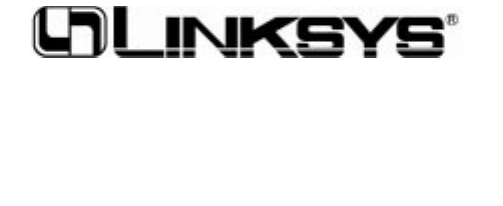
© Copyright 2001 Linksys,All Rights Reserved.
http://www.linksys.com